Search Result
Results for "
Cys269
" in MedChemExpress (MCE) Product Catalog:
| Cat. No. |
Product Name |
Target |
Research Areas |
Chemical Structure |
-
- HY-P1565A
-
|
TD 1 Disulfide(peptide) TFA
|
Na+/K+ ATPase
|
Others
|
|
Transdermal Peptide Disulfide TFA (TD 1 Disulfide(peptide) TFA) is a 11-amino acid peptide, binds to Na +/K +-ATPase beta-subunit (ATP1B1), and mainly interacts with the C-terminus of ATP1B1. Transdermal Peptide Disulfide TFA can enhance the transdermal delivery of many macromolecules .
|
-

-
- HY-149359
-
|
|
Isocitrate Dehydrogenase (IDH)
|
Cancer
|
|
IHMT-IDH1-053 (compound 16) is a highly selectivity and irreversible IDH1-mutant inhibitor with an IC50 of 4.7 nM for IDH1 R132H. IHMT-IDH1-053 displays high selectivity against IDH1 mutants over IDH1 wt and IDH2 wt/mutants. IHMT-IDH1-053 inhibits 2-hydroxyglutarate (2-HG) production in IDH1 R132H mutant transfected 293T cells (IC50=28 nM). IHMT-IDH1-053 binds to the IDH1 R132H protein in the allosteric pocket adjacent to the NAPDH binding pocket through a covalent bond with residue Cys269. IHMT-IDH1-053 inhibits the proliferation of HT1080 cell line and primary AML cells which both bear IDH1 R132 mutants .
|
-

-
- HY-P2569
-
|
|
Apoptosis
|
Cancer
|
|
Malformin A1, a cyclic pentapeptide isolated from Aspergillus niger, possess a range of bioactive properties including antibacterial activity. Malformin A1 shows potent cytotoxic activities on human colorectal cancer cells. Malformin A1 induces apoptosis by activating PARP, caspase 3, -7, and -9 .
|
-
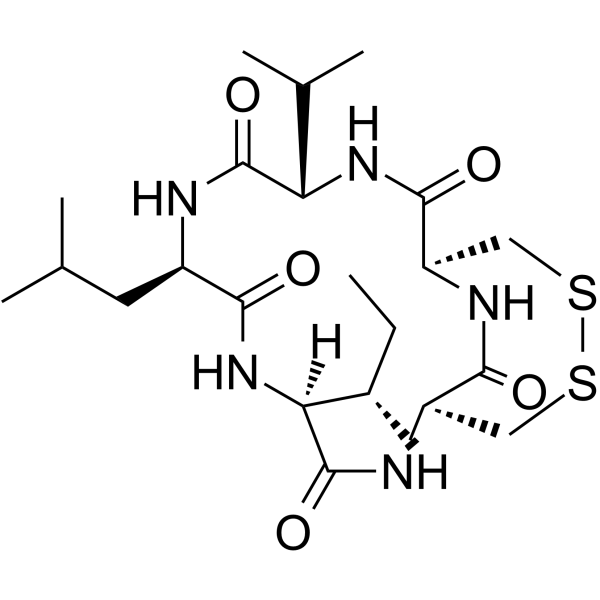
-
- HY-P1519
-
|
BNP (1-32), rat
|
Angiotensin Receptor
|
Cardiovascular Disease
|
|
Brain Natriuretic Peptide (1-32), rat (BNP (1-32), rat) is a 32 amino acid polypeptide secreted by the ventricles of the heart in response to excessive stretching of heart muscle cells (cardiomyocytes) .
|
-
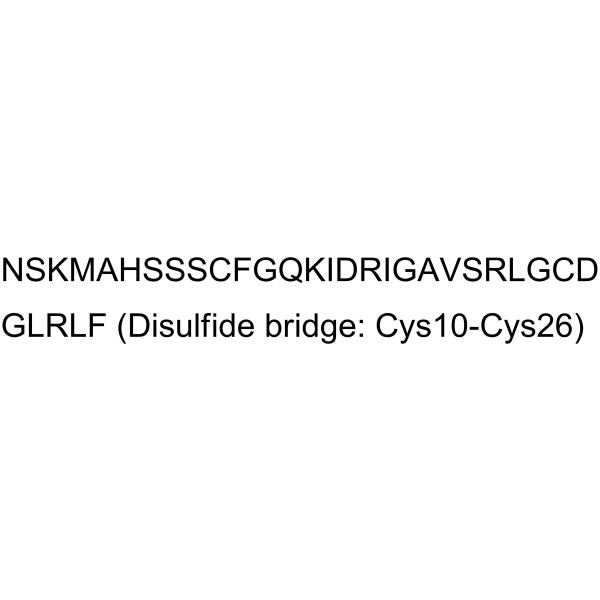
-
- HY-P1212
-
|
CST-14, human, rat
|
Somatostatin Receptor
|
Neurological Disease
|
|
Cortistatin 14, human, rat (CST-14, human, rat), a neuropeptide with neuronal depressant and sleep modulating properties, can bind to all five cloned somatostatin receptors (SSTRs) and ghrelin receptor to exert its biological activities and co-exists with GABA within the cortex and hippocampus .
|
-

-
- HY-P1519B
-
|
BNP (1-32), rat acetate
|
Angiotensin Receptor
|
Cardiovascular Disease
|
|
Brain Natriuretic Peptide (1-32), rat acetate (BNP (1-32), rat acetate) is a 32 amino acid polypeptide secreted by the ventricles of the heart in response to excessive stretching of heart muscle cells (cardiomyocytes) .
|
-
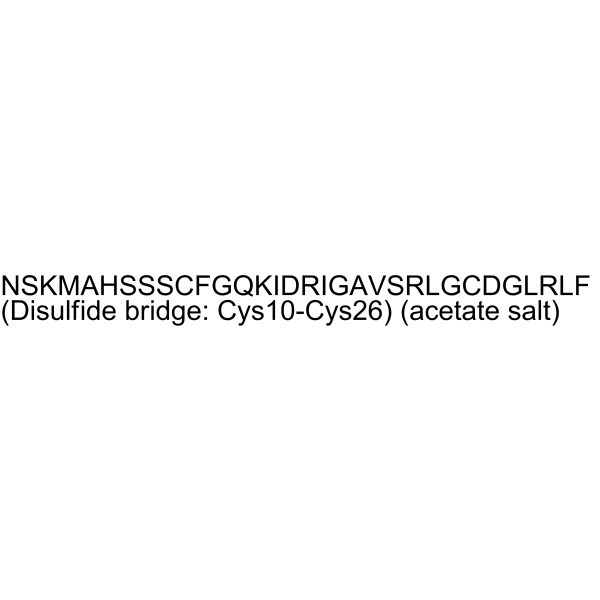
-
- HY-P10033
-
|
|
Ser/Thr Protease
|
Others
|
|
SFTI-1 is a cyclic peptide trypsin inhibitor comprising 14 amino acid residues. SFTI-1 is a potent Bowman-Birk inhibitor.
|
-
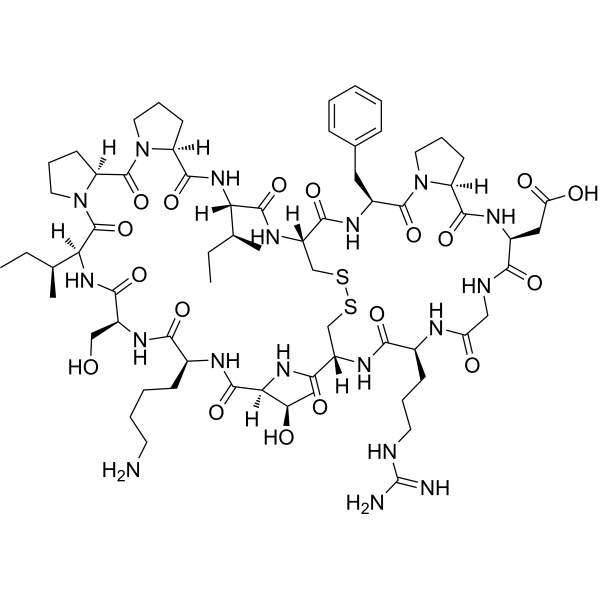
-
- HY-P1036
-
|
|
Complement System
|
Others
|
|
Compstatin, a 13-residue cyclic peptide, is a potent inhibitor of the complement system C3 with species specificity. Compstatin binds to baboon C3 and is resistant to proteolytic cleavage in baboon blood (similar to humans). Compstatin inhibits only the activation of primates’ complement system. Compstatin exhibits IC50 values of 63 μM and 12 μM for classical and alterative complement pathway, respectively .
|
-

-
- HY-P1464
-
|
Amylin (rat)
|
Amylin Receptor
|
Metabolic Disease
|
|
Amylin, amide, rat is a potent and high affinity ligand of Amylin receptor AMY1 and AMY3 receptors and variably of AMY2 receptors; binding studies are generally used for the latter receptor.
|
-

-
- HY-P1070
-
|
DAP amide, human
|
Amylin Receptor
|
Metabolic Disease
|
|
Amylin, amide, human, a 37-amino acid polypeptide, is a pancreatic hormone cosecreted with insulin that exerts unique roles in metabolism and glucose homeostasis. Amylin, amide, human inhibits glucagon secretion, delays gastric emptying, and acts as a satiety agent .
|
-
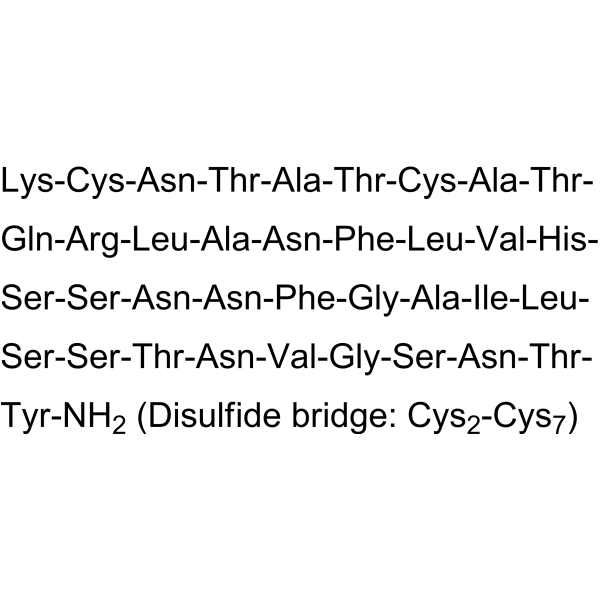
-
- HY-P1548
-
|
Human β-CGRP; CGRP-II (Human)
|
CGRP Receptor
|
Cardiovascular Disease
Inflammation/Immunology
|
|
β-CGRP, human (Human β-CGRP) is one of calcitonin peptides, acts via the complex of calcitonin-receptor-like receptor (CRLR) and receptor-activity-modifying protein (RAMP), with IC50s of 1 nM and 300 nM for CRLR/RAMP1 and CRLR/RAMP2 in cells .
|
-

-
- HY-P1548A
-
|
Human β-CGRP TFA; CGRP-II (Human) (TFA)
|
CGRP Receptor
|
Cardiovascular Disease
Inflammation/Immunology
|
|
β-CGRP, human TFA (Human β-CGRP TFA) is one of calcitonin peptides, acts via the complex of calcitonin-receptor-like receptor (CRLR) and receptor-activity-modifying protein (RAMP), with IC50s of 1 nM and 300 nM for CRLR/RAMP1 and CRLR/RAMP2 in cells .
|
-

-
- HY-P1871
-
|
|
Amylin Receptor
|
Metabolic Disease
|
|
Amylin (IAPP), feline is a 37-amino acid polypeptide from feline. Amylin (IAPP), feline is one of the major secretory products of β-cells of the pancreatic islets. Amylin (IAPP), feline is a regulatory peptide, which inhibits insulin and glucagon secretion .
|
-

-
- HY-P1913
-
|
|
CGRP Receptor
|
Cardiovascular Disease
|
|
Calcitonin Gene Related Peptide (CGRP) II, rat, a CGRP receptor activator, is a potent and long-lasting vasodilator. Calcitonin Gene Related Peptide (CGRP) II can be used in the research of cardiovascular diseases .
|
-

-
- HY-P1932
-
-
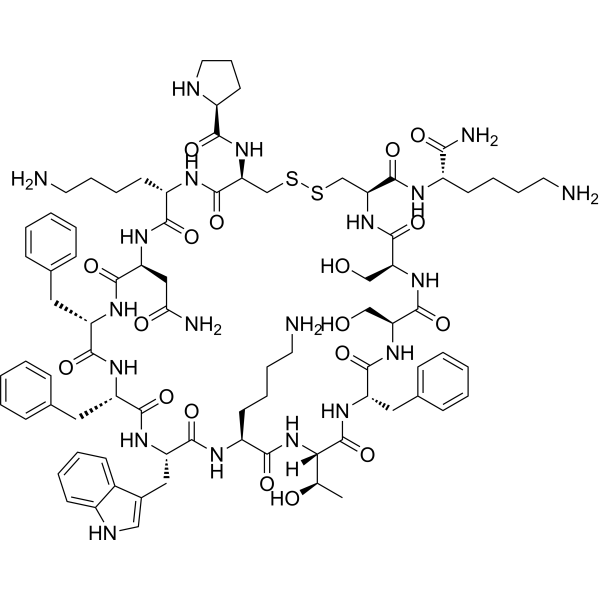
-
- HY-P1932A
-
-

-
- HY-P1913A
-
|
|
CGRP Receptor
|
Cardiovascular Disease
|
|
Calcitonin Gene Related Peptide (CGRP) II, rat TFA, a CGRP receptor activator, is a potent and long-lasting vasodilator. Calcitonin Gene Related Peptide (CGRP) II TFA can be used in the research of cardiovascular diseases .
|
-

-
- HY-P1070A
-
|
DAP amide, human TFA
|
Amylin Receptor
|
Metabolic Disease
|
|
Amylin, amide, human TFA, a 37-amino acid polypeptide, is a pancreatic hormone cosecreted with insulin that exerts unique roles in metabolism and glucose homeostasis. Amylin, amide, human TFA inhibits glucagon secretion, delays gastric emptying, and acts as a satiety agent .
|
-

-
- HY-P1548B
-
|
Human β-CGRP acetate; CGRP-II (Human) (acetate)
|
CGRP Receptor
|
Cardiovascular Disease
Inflammation/Immunology
|
|
β-CGRP, human acetate (Human β-CGRP acetate) is one of calcitonin peptides, acts via the complex of calcitonin-receptor-like receptor (CRLR) and receptor-activity-modifying protein (RAMP), with IC50s of 1 nM and 300 nM for CRLR/RAMP1 and CRLR/RAMP2 in cells .
|
-

-
- HY-P1105
-
|
|
Chloride Channel
|
Neurological Disease
|
|
GaTx2 is a seletive and a high affinity inhibitor of ClC-2 channels with a voltage-dependent apparent KD of ∼20 pM. GaTx2 is a peptide toxin inhibitor from Leiurus quinquestriatus hebraeus venom. GaTx2 is useful in determining the role and the membrane localization of ClC-2 in specific cell types .
|
-

-
- HY-P1871A
-
|
|
Amylin Receptor
|
Metabolic Disease
|
|
Amylin (IAPP), feline TFA is a 37-amino acid polypeptide from feline. Amylin (IAPP), feline TFA is one of the major secretory products of β-cells of the pancreatic islets. Amylin (IAPP), feline TFA is a regulatory peptide, which inhibits insulin and glucagon secretion .
|
-

-
- HY-P1036A
-
|
|
Complement System
|
Others
|
|
Compstatin TFA, a 13-residue cyclic peptide, is a potent inhibitor of the complement system C3 with species specificity. Compstatin TFA binds to baboon C3 and is resistant to proteolytic cleavage in baboon blood (similar to humans). Compstatin TFA inhibits only the activation of primates’ complement system. Compstatin TFA exhibits IC50 values of 63 μM and 12 μM for classical and alterative complement pathway, respectively .
|
-

-
- HY-P3314
-
-
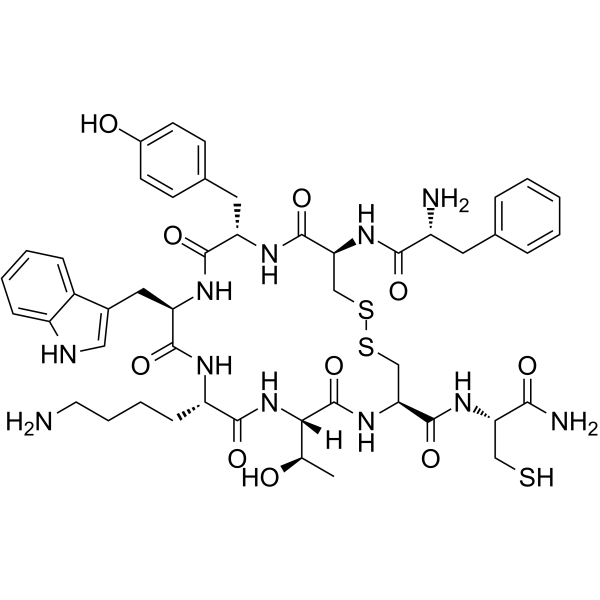
-
- HY-P10235
-
|
|
Amylin Receptor
|
Neurological Disease
|
|
Cyclic AC253 is an antagonist for amylin receptor, with IC50 of 0.3 μM. Cyclic AC253 exhibits neuroprotective efficacy against Aβ toxicity and abrogates Aβ-induced impairment of hippocampal long-term potentiation. Cyclic AC253 penetrate blood-brain barrier (BBB) .
|
-
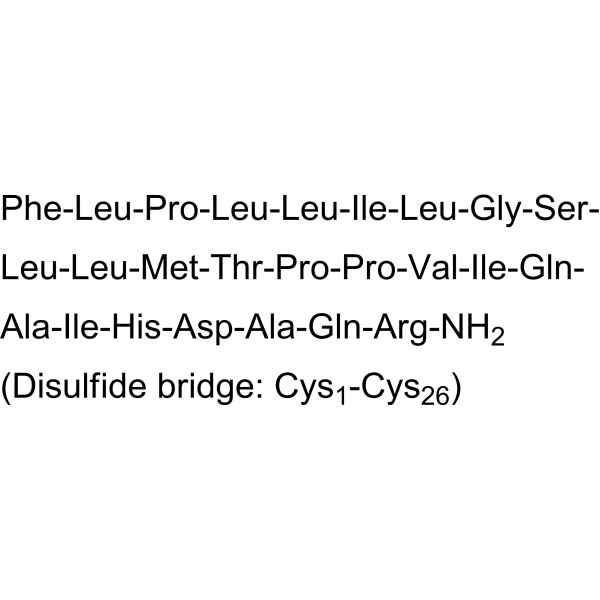
-
- HY-P3732
-
|
|
Integrin
|
Cancer
|
|
RGD-4C is a arginine-glycine-aspartic acid peptide (ACDCRGDCFC) with integrin binding activity. The Arg-Gly-Asp (RGD) sequence serves as the primary integrin recognition site in extracellular matrix proteins, and peptides containing this sequence can mimic the recognition specificity of the matrix proteins. RGD-4C is a αv-integrin ligand, can conjugate with bioactive molecule to exert antitumor effects in animal models .
|
-

-
- HY-P5809
-
-
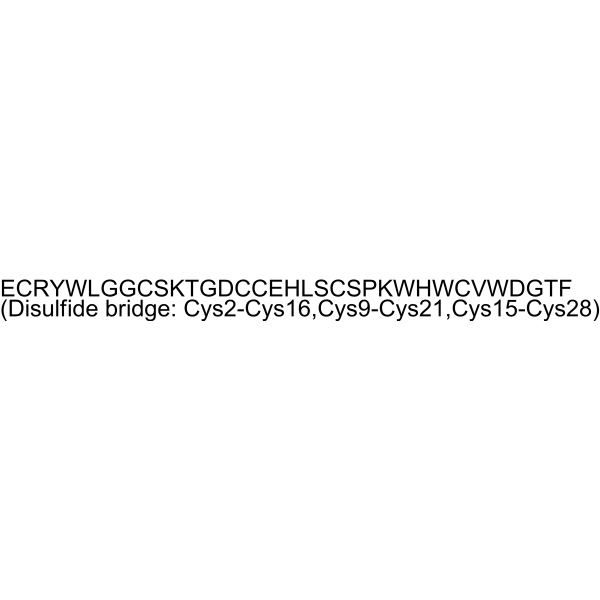
-
- HY-P5873
-
|
JZTX-X
|
Potassium Channel
|
Neurological Disease
|
|
Jingzhaotoxin-X (JZTX-X) is a selective Kv4.2 and Kv4.3 potassium channels inhibitor. Jingzhaotoxin-X causes long-lasting mechanical hyperalgesia .
|
-

-
- HY-P5785
-
|
|
Potassium Channel
|
Neurological Disease
|
|
Heteropodatoxin-2, a peptides of 30-amino acid, is a heteropodatoxin. Heteropodatoxin-2 blocks Kv4.2 current expressed in Xenopus laevis oocytes in a voltage-dependent manner, with less block at more positive potentials .
|
-

-
- HY-P5785A
-
|
|
Potassium Channel
|
Neurological Disease
|
|
Heteropodatoxin-2 (TFA), a peptides of 30-amino acid, is a heteropodatoxin. Heteropodatoxin-2 blocks Kv4.2 current expressed in Xenopus laevis oocytes in a voltage-dependent manner, with less block at more positive potentials .
|
-

-
- HY-P3282
-
|
|
Guanylate Cyclase
|
Metabolic Disease
|
|
MM 419447, a linaclotide metabolite, is a guanylate cyclase-C agonist. MM 419447 has the potential for the research of the irritable bowel syndrome with constipation (IBS-C) .
|
-

-
- HY-P4370
-
|
|
Bacterial
Fungal
|
Infection
|
|
Hepcidin-20 (human) is a histidine-containing, cysteine-rich, β-sheet structured peptide. Hepcidin-20 (human) shows antifungal activity. Hepcidin-20 (human) inhibits biofilm formation and bacterial cell metabolism of polysaccharide intercellular adhesin (PIA)-positive and PIA-negative strains .
|
-

-
- HY-P5146
-
-
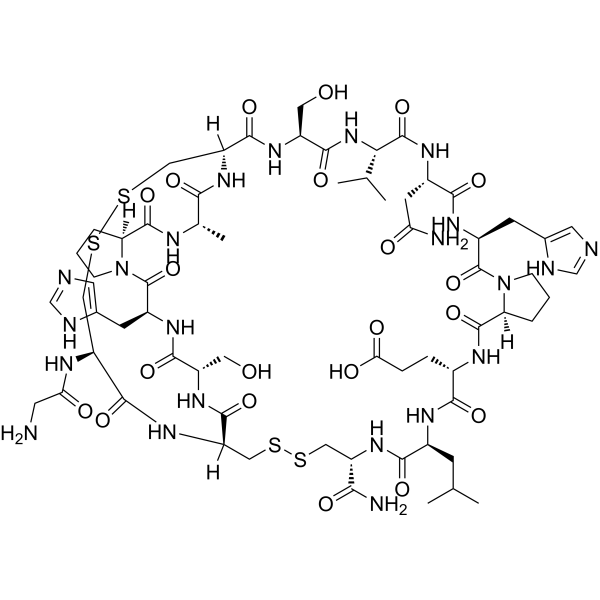
-
- HY-P5148
-
|
|
nAChR
|
Neurological Disease
|
|
α-Conotoxin BuIA is a paralytic peptide neurotoxin and a competitive nAChR antagonist, with IC50s of 0.258 nM (α6/α3β2), 1.54 nM (α6/α3β4), 5.72 nM (α3β2), respectively. α-Conotoxin BuIA can be used to distinguish nAChRs containing β2- and β4-subunit, respectively. α-Conotoxin BuIA distinguishes among αxβ2 nAChRs with a rank order potency of α6>α3>α2>α4 .
|
-
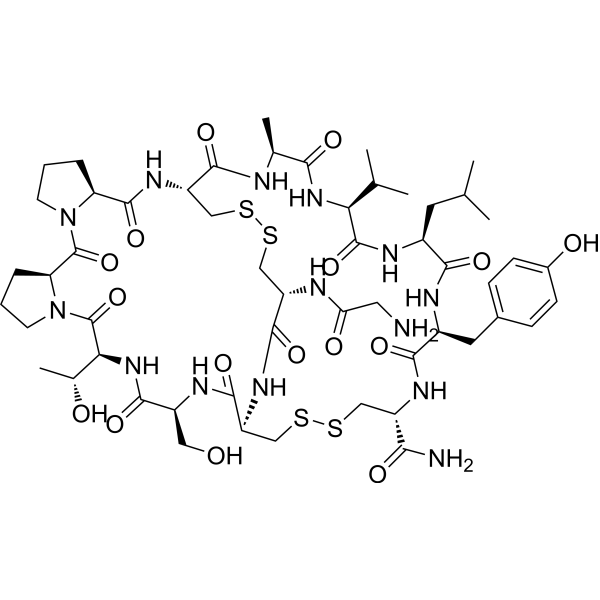
-
- HY-P5157
-
|
|
Potassium Channel
|
Neurological Disease
|
|
BmP02 is a selective Kv1.3 channel blocker and a highly-selective Kv4.2 modulator, which can be isolated from Chinese scorpion (Buthus martensi Karsch) venom. BmP02 also delays the inactivation of Kv4.2 in HEK293T cells, with an EC50 value of ~850 nM. BmP02 inhibits the transient outward potassium currents (Ito) in ventricular muscle cells .
|
-

-
- HY-P1681
-
-
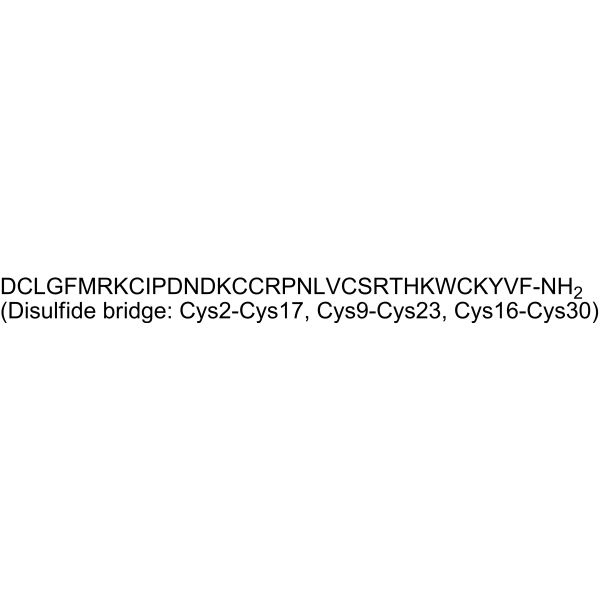
-
- HY-P5871
-
|
JzTx-XII
|
Potassium Channel
|
Others
|
|
Jingzhaotoxin-XII (JzTx-XII) is a specific Kv4.1 channel inhibitor with an IC50 of 0.363 μM. Jingzhaotoxin-XII interacts with the channels by modifying the gating behavior .
|
-
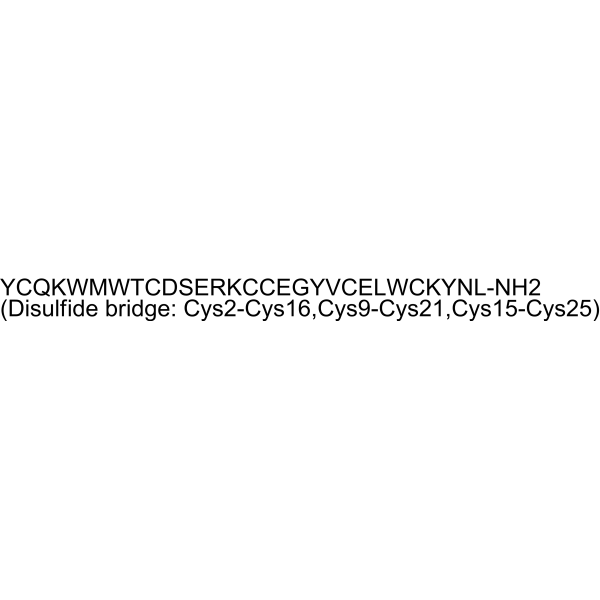
-
- HY-P5872
-
|
JZTX-XI
|
Sodium Channel
|
Neurological Disease
|
|
Jingzhaotoxin XI (JZTX-XI) is a sodium conductance inhibitor with an IC50 of 124 nM. Jingzhaotoxin XI slows the fast inactivation (EC50=1.18±0.2 μM) of Nav1.5 expressed in Chinese hamster ovary (CHO-K1) cells .
|
-
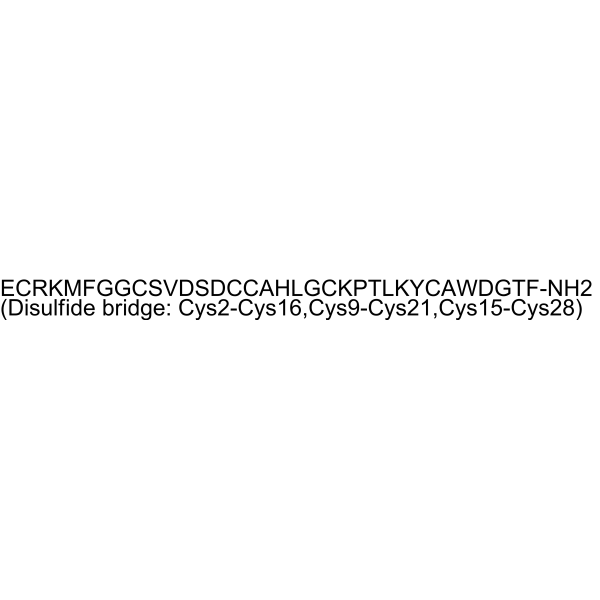
-
- HY-P5900
-
|
m3-HwTx-IV
|
Sodium Channel
|
Neurological Disease
|
|
m3-Huwentoxin IV (m3-HwTx-IV) is a potent NaV inhibitor with IC50s of 3.3, 6.8, 7.2, 8.4, 11.9 and 369 nM against hNaV1.7, hNaV1.6, hNaV1.3, hNaV1.1, hNaV1.2 and hNaV1.4, respectively in QPatch assay. m3-Huwentoxin IV dose-dependently suppresses spontaneous pain induced by the NaV1.7 activator OD1 in a rodent pain model .
|
-
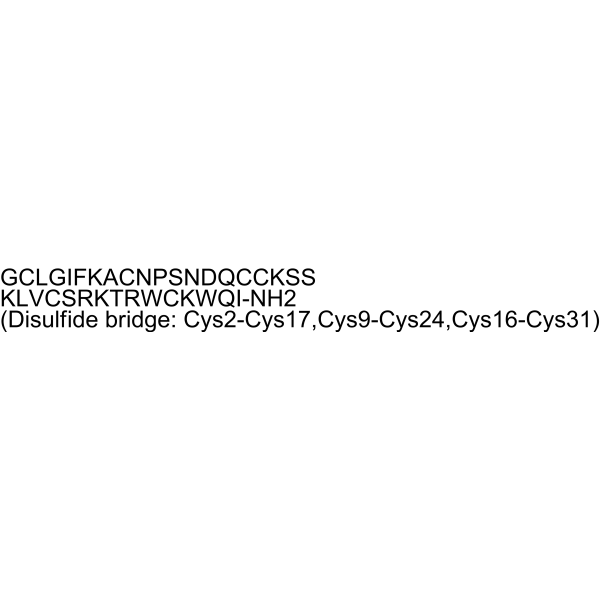
-
- HY-P5800
-
|
μ-TrTx-Phlo1b
|
Sodium Channel
|
Neurological Disease
|
|
Phlo1b (μ-TrTx-Phlo1b) is a peptide toxin contains 35-amino acid residues. Phlo1b is a selective Nav1.7 inhibitor. Phlo1b has a weak inhibitory effect on Nav1.2 and Nav1.5 .
|
-
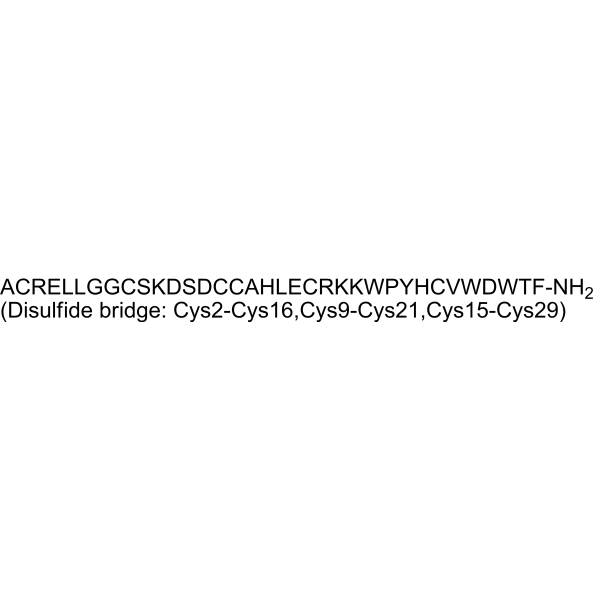
-
- HY-P5801
-
|
μ-TrTx-Phlo1a
|
Sodium Channel
|
Neurological Disease
|
|
Phlo1a (μ-TrTx-Phlo1a) is a peptide toxin contains 35-amino acid residues. Phlo1b is a selective Nav1.7 inhibitor. Phlo1a has a weak inhibitory effect on Nav1.2 and Nav1.5 .
|
-

-
- HY-P5942
-
-
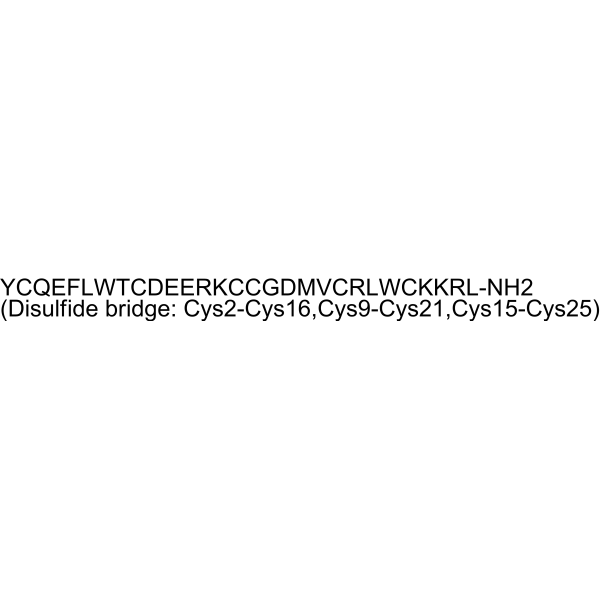
-
- HY-108814
-
|
DX-88
|
Ser/Thr Protease
|
Cardiovascular Disease
|
|
Ecallantide (DX-88) is a specific plasma kallikrein inhibitor. Ecallantide inhibits the production of bradykinin. Ecallantide can be used to prevent acute attacks of angioedema .
|
-

-
- HY-108814A
-
|
DX-88 TFA
|
Kallikrein
|
Cardiovascular Disease
|
|
Ecallantide (DX-88) TFA is a specific recombinant plasma kallikrein inhibitor. Ecallantide inhibits the production of bradykinin. Ecallantide may be used to prevent acute attacks of angioedema .
|
-

-
- HY-P0173A
-
|
|
Chloride Channel
|
Cancer
|
|
Chlorotoxin is a 36 amino-acid peptide from the venom of the Israeli scorpion Leiurus quinquestriatus with anticancer activity. Chlorotoxin is a chloride channel blocker.
|
-

-
- HY-P0173B
-
|
|
Chloride Channel
|
Cancer
|
|
Chlorotoxin TFA is a peptide isolated from the venom of the scorpion Leiurus quinquestriatus, acts as a chloride channel blocker . Anti-cancer activity .
|
-
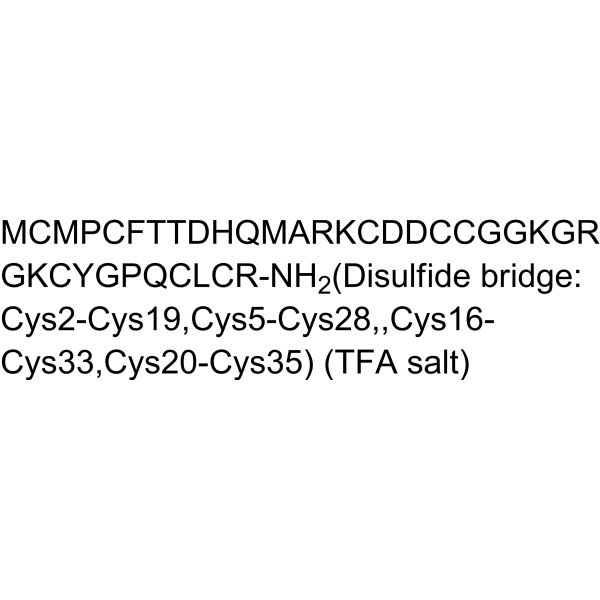
-
- HY-P5164
-
|
|
Sodium Channel
|
Neurological Disease
|
|
GrTx1 is a peptide toxin originally isolated from the venom of the spider Grammostola rosea. GrTx1 blocks sodium channel, with IC50s of 0.63 µM, 0.23 µM, 0.77 µM, 1.29 µM, 0.63 µM and 0.37 µM for Nav1.1, Nav1.2, Nav1.3, Nav1.4, Nav1.6 and Nav1.7, repectively .GrTx1 can be used for neurological disease research .
|
-

-
- HY-P5153
-
|
μ-TRTX-Tp1a
|
Sodium Channel
|
Neurological Disease
|
|
ProTx-III is a selective and potent inhibitor of voltage-gated sodium channel Nav1.7, with an IC50 of 2.1 nM. ProTx-III is a spider venom peptide isolated from the venom of the Peruvian green velvet tarantella. ProTx-III has a typical inhibitor cystine knot motif (ICK). ProTx-III is able to reverse the pain response. ProTx-III can be used to study diseases such as chronic pain, epilepsy, and arrhythmia .
|
-

-
- HY-P5160
-
|
PhlTx1
|
Sodium Channel
|
Inflammation/Immunology
|
|
Phlotoxin-1 (PhlTx1) is a 34-amino acid and 3-disulfide bridge peptide. Phlotoxin-1 can be isolated from Phlogiellus genus spider. Phlotoxin-1 is an antinociceptive agent by inhibiting NaV1.7 channel .
|
-

-
- HY-P5183
-
|
|
Sodium Channel
|
Neurological Disease
|
|
Hm1a is a disulfide-rich spider-venom peptide, and a NaV1.1 activator. Hm1a restores the function of inhibitory interneurons in Dravet syndrome (DS) mouse model .
|
-

-
- HY-P5861
-
-
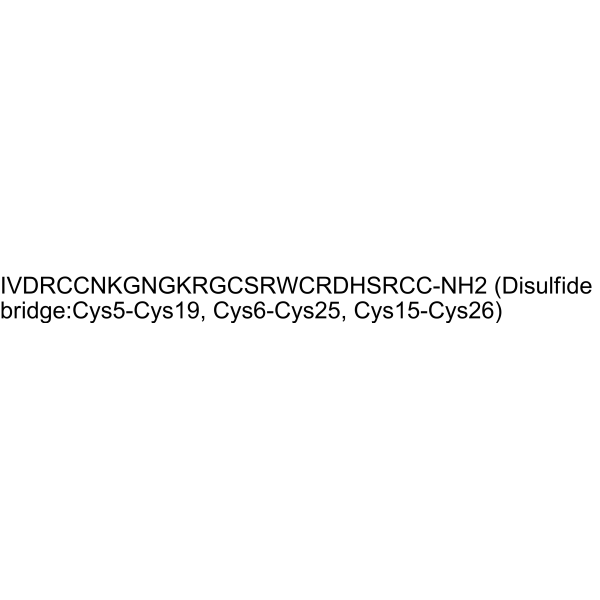
- HY-P5868
-
|
|
Sodium Channel
|
Neurological Disease
|
|
mHuwentoxin-IV is a naturally modified Huwentoxin-IV (HY-P1220). mHuwentoxin-IV inhibits tetrodotoxin-sensitive (TTX-S) voltage-gated sodium channels of dorsal root ganglion neurons with an IC50 of 54.16 nM. mHuwentoxin-IV inhibition of tetrodotoxin-sensitive sodium channels is not reversed by strong depolarization voltages .
|
-

- HY-P5179
-
|
HWTX-I
|
Calcium Channel
Sodium Channel
|
Neurological Disease
|
|
Huwentoxin I (HWTX-I) is a peptide toxin that inhibits voltage-gated sodium channels and N-type calcium channels. Huwentoxin I inhibits sodium channels in rat hippocampus and cockroach dorsal unpaired median (DUM) neurons with IC50 values of 66.1 and 4.80 nM, respectively .
|
-

- HY-P5177
-
-

- HY-P1202
-
|
|
Somatostatin Receptor
|
Endocrinology
|
|
CYN 154806, a cyclic octapeptide, is a potent and selective somatostatin sst2 receptor antagonist, with pIC50 values of 8.58, 5.41, 6.07, 5.76 and 6.48 for human recombinant sst2, sst1, sst3, sst4 and sst5 receptors respectively .
|
-

- HY-P1202A
-
|
|
Somatostatin Receptor
|
Endocrinology
|
|
CYN 154806 TFA, a cyclic octapeptide, is a potent and selective somatostatin sst2 receptor antagonist, with pIC50 values of 8.58, 5.41, 6.07, 5.76 and 6.48 for human recombinant sst2, sst1, sst3, sst4 and sst5 receptors respectively .
|
-
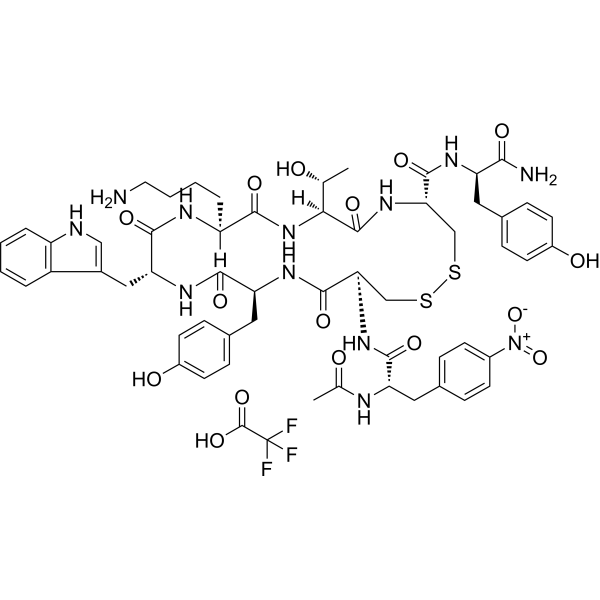
- HY-P0188A
-
|
|
Calcium Channel
|
Neurological Disease
|
|
ω-Conotoxin MVIIC TFA is a N- and P/Q-type Ca 2+ channel blocker, significantly suppresses the 11-keto-βboswellic acid-mediated inhibition of glutamate release .
|
-
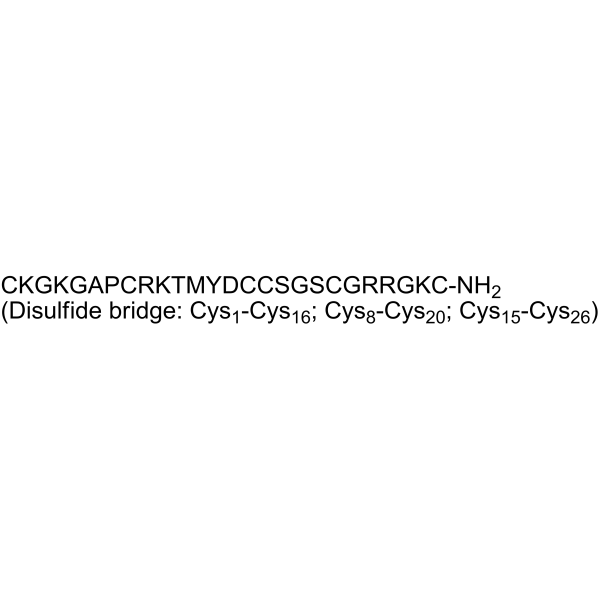
- HY-P2112
-
|
DOTA-Nal3-octreotide
|
Somatostatin Receptor
|
Others
|
|
DOTA-NOC (DOTA-Nal3-octreotide) is a high-affinity ligand of somatostatin receptor subtypes 2, 3 and 5. DOTA-NOC can be used for labeling with various radiometals, and development of radiopeptide imaging .
|
-

- HY-P5155
-
|
|
Potassium Channel
|
Neurological Disease
|
|
Stromatoxin 1 is an inhibitor of Potassium Channel, a peptide which can be isolated from tarantulas. Stromatoxin 1 selectively inhibits K(V)2.1, K(V)2.2, K(V)4.2, and K(V)2.1/9.3 channels. K(V)2.1 and K(V)2.2, but not K(V)4.2, channel subunits play a key role in opposing both myogenic and neurogenic urinary bladder smooth muscle (UBSM) contractions in rats .
|
-
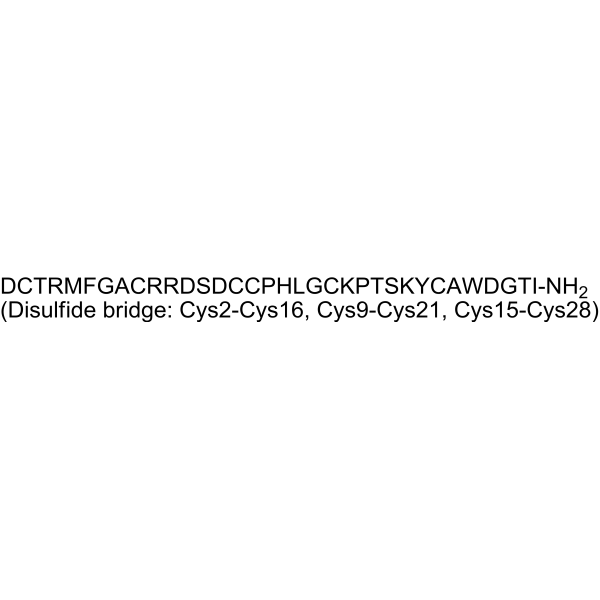
- HY-P5184
-
|
HNTX-IV
|
Sodium Channel
|
Neurological Disease
|
|
Hainantoxin-IV is a specific antagonist of Sodium Channel, targeting to tetrodotoxin-sensitive (TTX-S) voltage-gated sodium channels. His28 and Lys32 are the key resiudes of Hainantoxin-IV for binding with target, while Hainantoxin-IV adopts an inhibitor cystine knot motif .
|
-
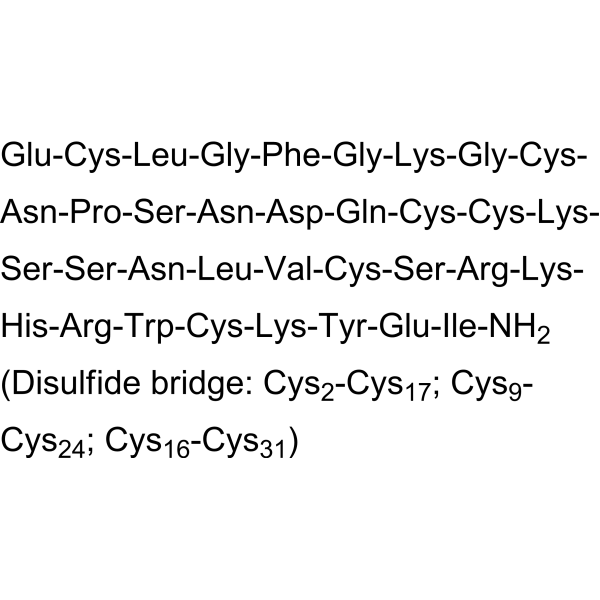
- HY-P5336
-
-
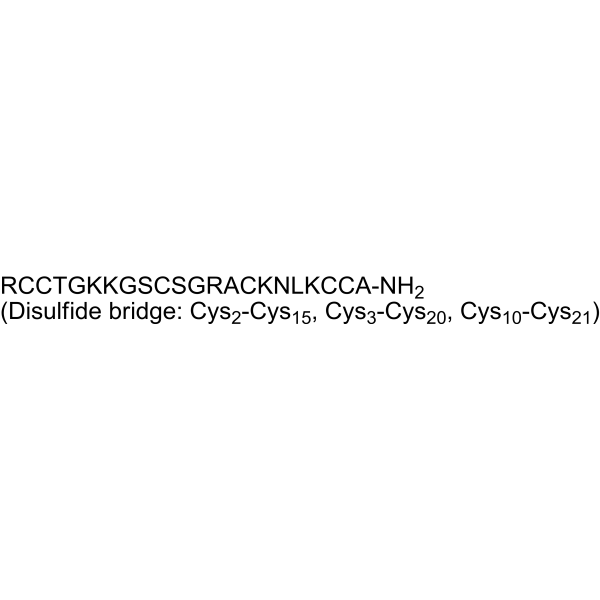
- HY-P2785
-
-

- HY-P5180
-
|
|
Sodium Channel
|
Neurological Disease
|
|
Jingzhaotoxin-V is a peptide that inhibits potassium currents in Xenopus laevis oocytes with an IC50 value of 604.2 nM. Jingzhaotoxin-V also inhibits tetrodotoxin-resistant and tetrodotoxin-sensitive sodium currents in rat dorsal root ganglion neurons with IC50 values of 27.6 and 30.2 nM, respectively .
|
-

- HY-P5626
-
|
|
Bacterial
|
Infection
|
|
Seabream hepcidin is an antimicrobial peptide with anti-bacterial (V.anguillarum), fungal (S.cerevisiae) and viral hemorrhagic septicemia virus activity .
|
-
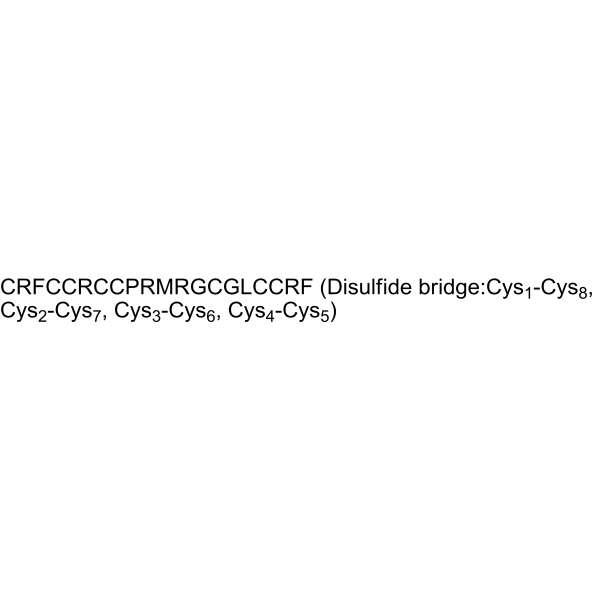
- HY-P2786A
-
-
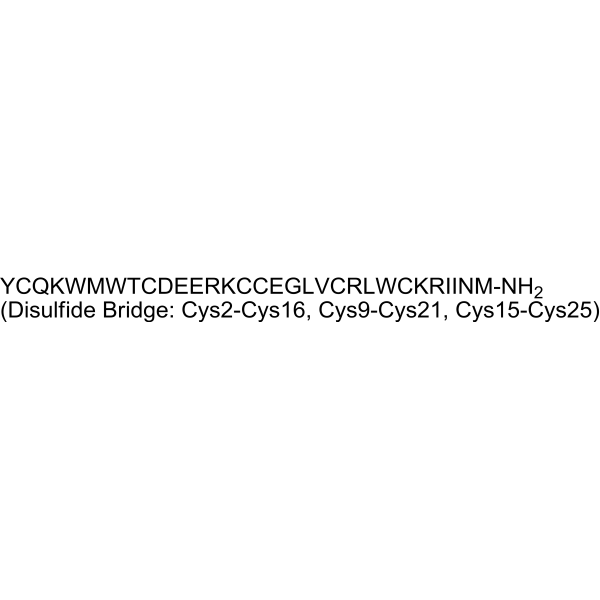
- HY-P2785A
-
-
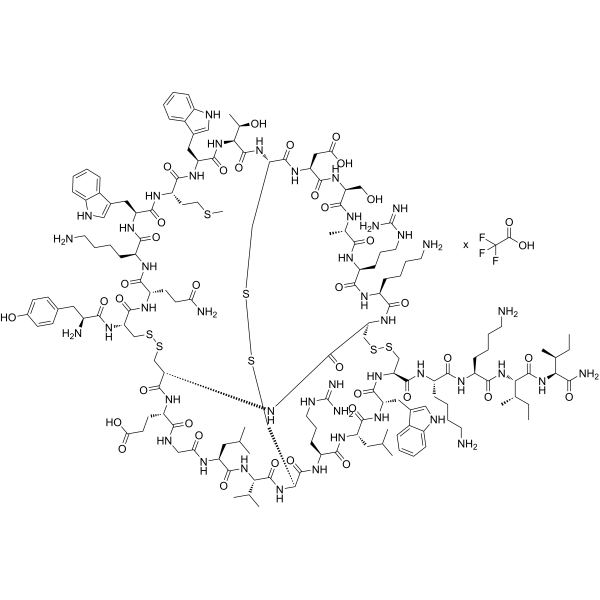
- HY-P0061
-
-

- HY-P0061A
-
|
RC-160 acetate; BMY-41606 acetate
|
Neurokinin Receptor
|
Cancer
|
|
Vapreotide acetate (RC-160 acetate; BMY-41606 acetate) is a neurokinin-1 (NK1) receptor antagonist, with an IC50 of 330 nM.
|
-

- HY-P0036
-
Octreotide
Maximum Cited Publications
10 Publications Verification
SMS 201-995
|
Somatostatin Receptor
Apoptosis
|
Cardiovascular Disease
Inflammation/Immunology
Endocrinology
Cancer
|
|
Octreotide (SMS 201-995) is a somatostatin receptor agonist and synthetic octapeptide endogenous somatostatin analogue. Octreotide (SMS 201-995) can bind to the somatostatin receptor and mainly subtypes 2, 3, and 5, increases Gi activity, and reduces intracellular cAMP production. Octreotide (SMS 201-995) has antitumor activity, mediates apoptosis and may also be used in disease studies in acromegaly .
|
-
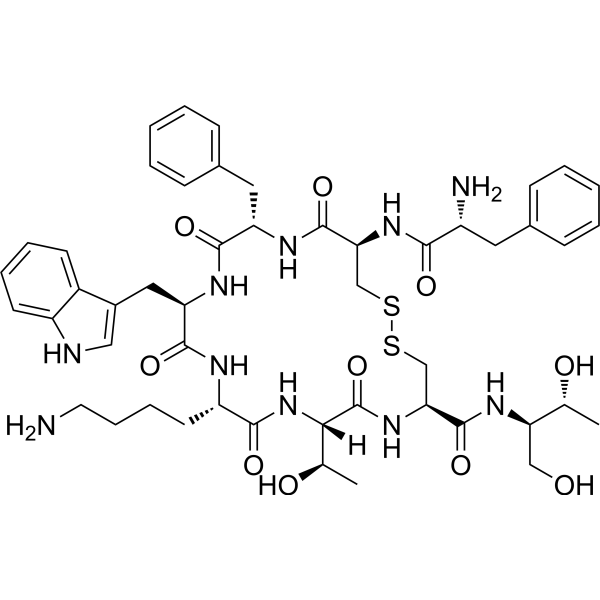
- HY-P1980
-
|
|
Apoptosis
|
Metabolic Disease
|
|
A-71915 (TFA) is a selective inhibitor of ANP receptor (atrial natriuretic peptide-receptor), induces apoptosis and decreases insulin secretion in RINm5F pancreatic β-cells .
|
-
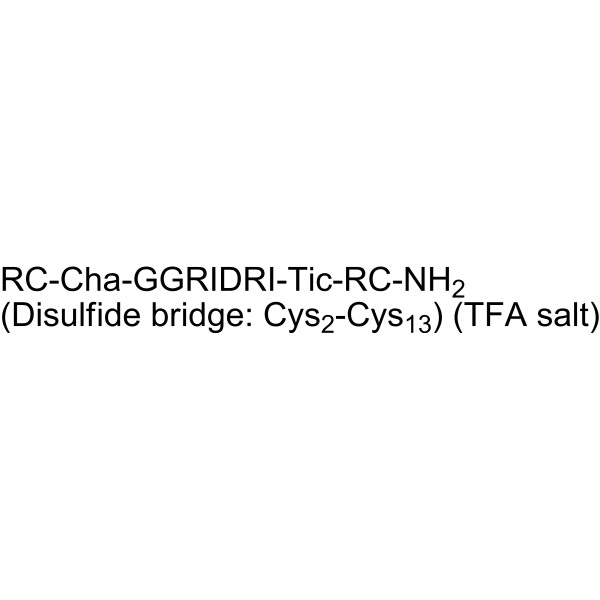
- HY-P0036B
-
|
SMS 201-995 pamoate
|
Somatostatin Receptor
Apoptosis
|
Cardiovascular Disease
Inflammation/Immunology
Endocrinology
Cancer
|
|
Octreotide (SMS 201-995) pamoate is a somatostatin receptor agonist and synthetic octapeptide endogenous somatostatin analogue. Octreotide pamoate can bind to the somatostatin receptors which are mainly subtypes 2, 3 and 5. Octreotide pamoate increases Gi activity and reduces intracellular cAMP production. Octreotide pamoate has antitumor activity, mediates apoptosis and may also be used in disease studies in acromegaly .
|
-
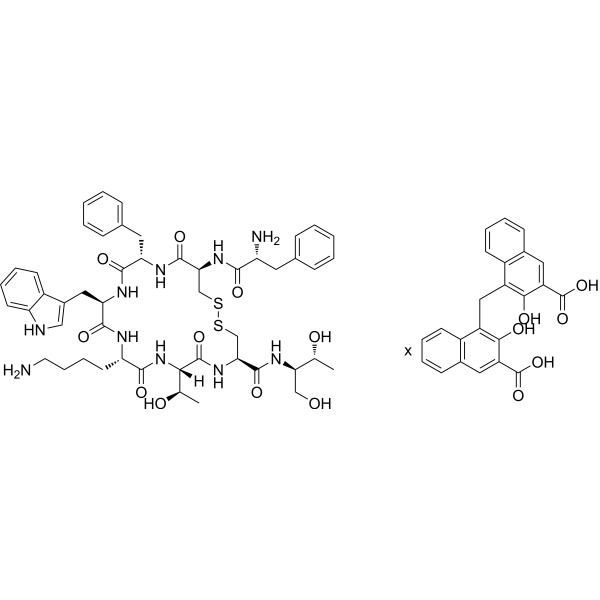
- HY-P5144
-
-

- HY-P5902
-
-

- HY-P4764
-
|
|
Melanocortin Receptor
|
Cardiovascular Disease
|
|
Ac-DArg-c[Cys-Glu-His-DPhe-Arg-Trp-Cys]-NH 2 is a cyclic octapeptide with MC4R agonism. Ac-DArg-c[Cys-Glu-His-DPhe-Arg-Trp-Cys]-NH 2 significantly increases heart rate and blood pressure .
|
-
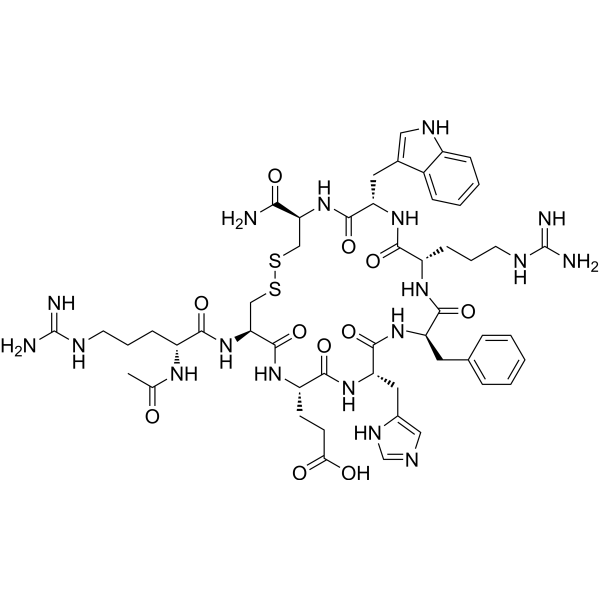
- HY-P1682A
-
|
POL6326 TFA
|
CXCR
Arrestin
|
Cancer
|
|
Balixafortide TFA (POL6326 TFA) is a potent, selective, well-tolerated peptidic CXCR4 antagonist with an IC50 < 10 nM. Balixafortide TFA shows 1000-fold selective for CXCR4 than a large panel of receptors including CXCR7. Balixafortide TFA blocks β-arrestin recruitment and calcium flux with IC50s < 10 nM. Balixafortide TFA is also a potent hematopoietic stem and progenitor cell (HSPC) mobilizing agent. Anti-cancer effects .
|
-

- HY-P1682
-
|
POL6326
|
CXCR
Arrestin
|
Cancer
|
|
Balixafortide (POL6326) is a potent, selective, well-tolerated peptidic CXCR4 antagonist with an IC50 < 10 nM. Balixafortide shows 1000-fold selective for CXCR4 than a large panel of receptors including CXCR7. Balixafortide blocks β-arrestin recruitment and calcium flux with IC50s < 10 nM. Balixafortide is also a potent hematopoietic stem and progenitor cell (HSPC) mobilizing agent. Anti-cancer effects .
|
-
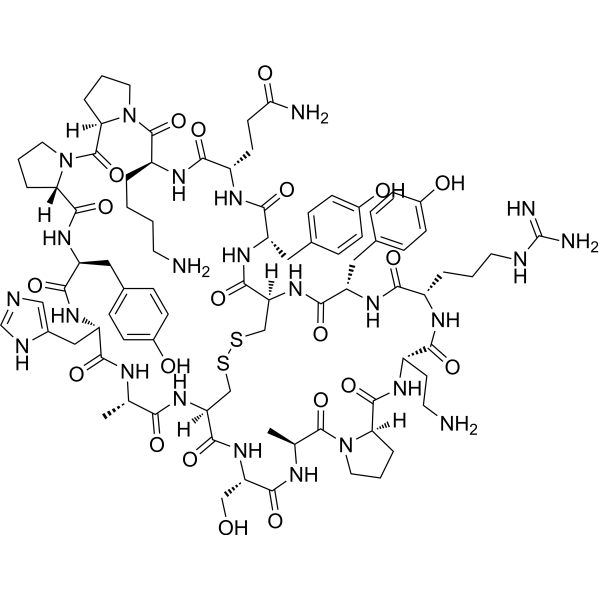
- HY-P4745
-
|
|
MCHR1 (GPR24)
|
Metabolic Disease
|
|
hMCH-1R antagonist 1 (Compound 30) is an effective and selective antagonist of human melanin-concentrating hormone receptor 1 (hMCHR1) with an KB value of 3.6 nM. HMCH-1R antagonist 1 can bind to hMCHR1 and hMCHR2 with IC50 values of 65 nM and 49 nM, respectively. HMCH-1R antagonistist 1 can be used for metabolic research .
|
-
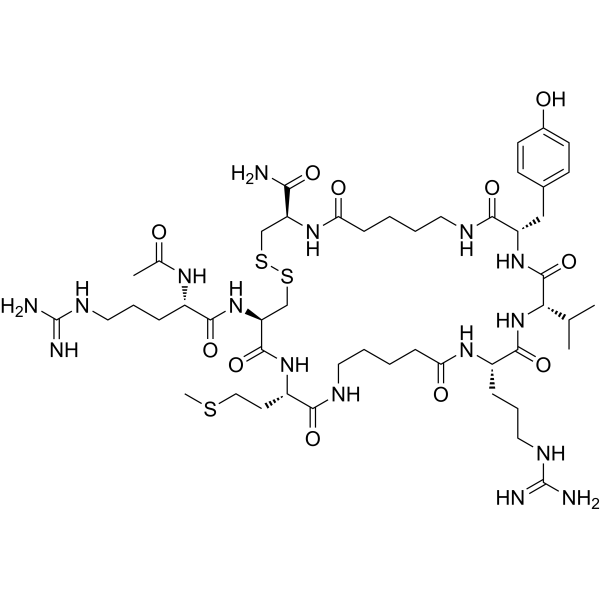
- HY-P10273
-
|
|
Biochemical Assay Reagents
|
Cancer
|
|
DOTA-Octreotide is composed of chelator DOTA and Octreotide (HY-P0036). DOTA-Octreotide is utilized for diagnosis and therapy of cancer, through combination with radioactive elements .
|
-

- HY-P3561
-
|
|
Melanocortin Receptor
|
Neurological Disease
|
|
Agouti-related Protein (AGRP) (83-132) Amide (human) is a fragment of agouti-related protein (AGRP) which is a protein found in abundance in the arcuate nucleus of the hypothalamus. AgRP primarily acts as an inverse agonist for the melanocortin-4 receptor (MC4R) to increase food intake .
|
-

- HY-P4555
-
|
|
Somatostatin Receptor
|
Neurological Disease
|
|
(D-Phe5,Cys6,11,N-Me-D-Trp8)-Somatostatin-14 (5-12) amide (Compound 4) is a somatostatin analog with Kds of 0.61, 11.05, 23.5, 1200 and >1000 nM for SSTR5, SSTR3, SSTR2, SSTR1 and SSTR4, respectively .
|
-
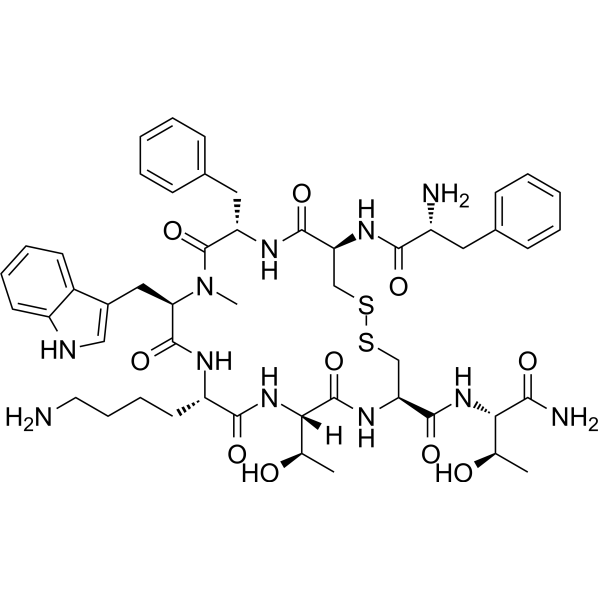
- HY-P3561A
-
|
|
Melanocortin Receptor
|
Neurological Disease
|
|
Agouti-related Protein (AGRP) (83-132) Amide (human) TFA is a fragment of agouti-related protein (AGRP) which is a protein found in abundance in the arcuate nucleus of the hypothalamus. AgRP primarily acts as an inverse agonist for the melanocortin-4 receptor (MC4R) to increase food intake .
|
-

- HY-P0189A
-
-

- HY-P3124A
-
|
|
Somatostatin Receptor
|
Cancer
|
|
BIM-23190 hydrochloride, a somatostatin analog, a selective SSRT2 and SSRT5 agonist, exhibits Ki values of 0.34 nM and 11.1 nM for SSTR2 and SSTR5, respectively. BIM-23190 can be used in the study for cancer and acromegaly .
|
-
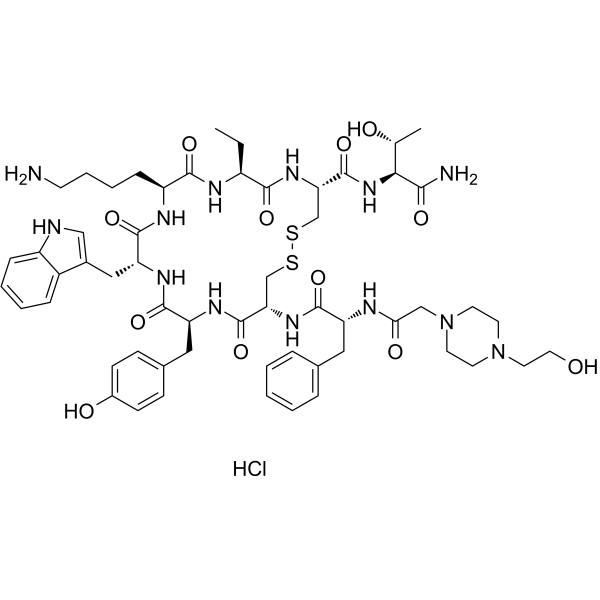
- HY-P3124
-
|
|
Somatostatin Receptor
|
Cancer
|
|
BIM-23190, a somatostatin analog, a selective SSTR2 and SSTR5 agonist, exhibits Ki values of 0.34 nM and 11.1 nM for SSTR2 and SSTR5, respectively. BIM-23190 can be used in the study for cancer and acromegaly .
|
-
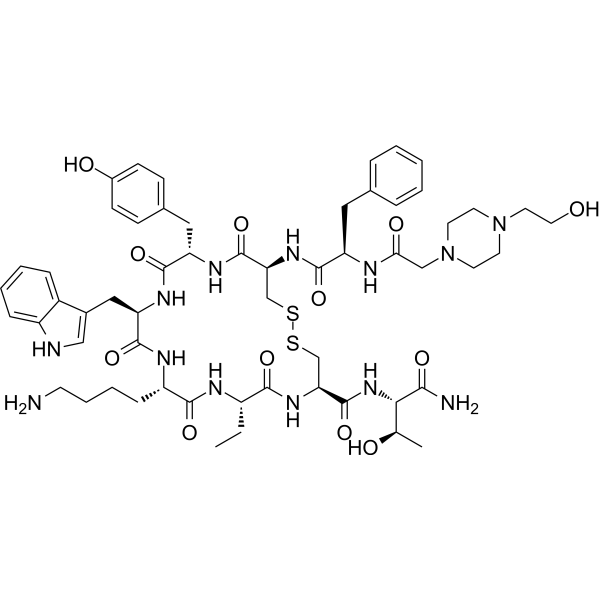
- HY-P2434
-
|
|
Somatostatin Receptor
|
Neurological Disease
Metabolic Disease
Cancer
|
|
AP102 is a dual SSTR2/SSTR5-specific somatostatin analog (SSA). AP102 is a disulfide-bridged octapeptide SSA containing synthetic iodinated amino acids. AP102 binds with subnanomolar affinity to SSTR2 and SSTR5 (IC50: 0.63 and 0.65 nM, respectively). AP102 does not bind to SSTR1 or SSTR3. AP102 can be used for acromegaly and neuroendocrine tumors research .
|
-
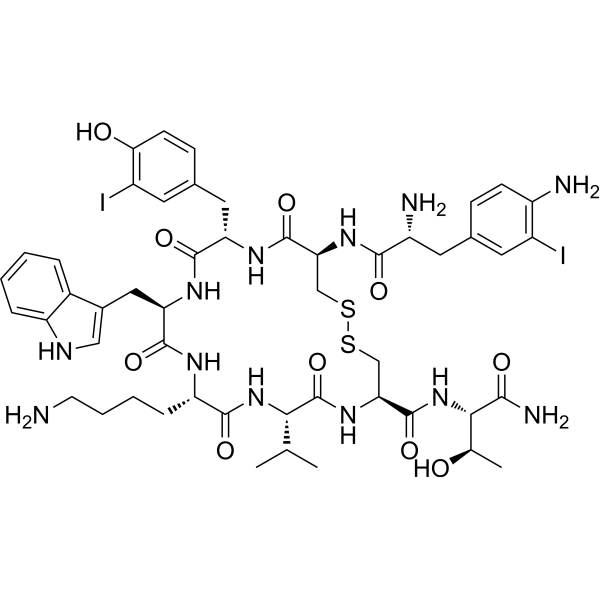
- HY-P5362
-
|
|
Somatostatin Receptor
|
Cancer
|
|
NODAGA-LM3 can be labeled by 68Ga for PET imaging. 68Ga-NODAGA-LM3 is a SSTR2 antagonist, and can be used for imaging of SSTR positive paragangliomas .
|
-
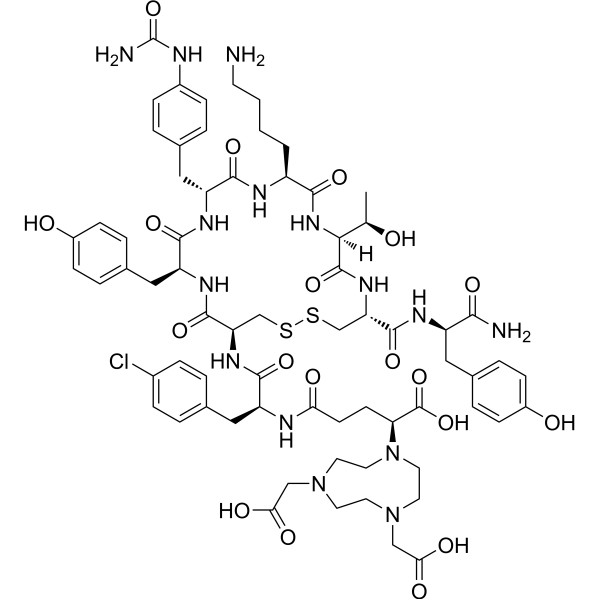
- HY-P5362A
-
|
|
Somatostatin Receptor
|
Cancer
|
|
NODAGA-LM3 TFA can be labeled by 68Ga for PET imaging. 68Ga-NODAGA-LM3 TFA is a SSTR2 antagonist, and can be used for imaging of SSTR positive paragangliomas .
|
-

| Cat. No. |
Product Name |
Target |
Research Area |
-
- HY-P4058
-
|
CGRP free acid
|
Peptides
|
Neurological Disease
|
|
Calcitonin gene-related peptide (CGRP) free acid is a neuropeptide. Calcitonin gene-related peptide can be used for the research of nociception, ingestive behaviour and modulation of the endocrine systems .
|
-
- HY-P0003
-
|
Brain Natriuretic Peptide-32 human; BNP-32
|
Peptides
|
Cancer
|
|
Nesiritide (Brain Natriuretic Peptide-32 human) is an agonist of natriuretic peptide receptors (NPRs), with Kd values of 7.3 and 13 pM for NPR-A and NPR-C, respectively.
|
-
- HY-P0123
-
|
|
Peptides
|
Others
|
|
SPACE peptide is a skin penetrating peptide (SPPs). SPACE peptide can enhance topical delivery of a macromolecule, hyaluronic acid .
|
-
- HY-P2569
-
|
|
Apoptosis
|
Cancer
|
|
Malformin A1, a cyclic pentapeptide isolated from Aspergillus niger, possess a range of bioactive properties including antibacterial activity. Malformin A1 shows potent cytotoxic activities on human colorectal cancer cells. Malformin A1 induces apoptosis by activating PARP, caspase 3, -7, and -9 .
|
-
- HY-P1519
-
|
BNP (1-32), rat
|
Angiotensin Receptor
|
Cardiovascular Disease
|
|
Brain Natriuretic Peptide (1-32), rat (BNP (1-32), rat) is a 32 amino acid polypeptide secreted by the ventricles of the heart in response to excessive stretching of heart muscle cells (cardiomyocytes) .
|
-
- HY-P1212
-
|
CST-14, human, rat
|
Somatostatin Receptor
|
Neurological Disease
|
|
Cortistatin 14, human, rat (CST-14, human, rat), a neuropeptide with neuronal depressant and sleep modulating properties, can bind to all five cloned somatostatin receptors (SSTRs) and ghrelin receptor to exert its biological activities and co-exists with GABA within the cortex and hippocampus .
|
-
- HY-P1565A
-
|
TD 1 Disulfide(peptide) TFA
|
Na+/K+ ATPase
|
Others
|
|
Transdermal Peptide Disulfide TFA (TD 1 Disulfide(peptide) TFA) is a 11-amino acid peptide, binds to Na +/K +-ATPase beta-subunit (ATP1B1), and mainly interacts with the C-terminus of ATP1B1. Transdermal Peptide Disulfide TFA can enhance the transdermal delivery of many macromolecules .
|
-
- HY-P1519B
-
|
BNP (1-32), rat acetate
|
Angiotensin Receptor
|
Cardiovascular Disease
|
|
Brain Natriuretic Peptide (1-32), rat acetate (BNP (1-32), rat acetate) is a 32 amino acid polypeptide secreted by the ventricles of the heart in response to excessive stretching of heart muscle cells (cardiomyocytes) .
|
-
- HY-P4767
-
|
|
Peptides
|
Metabolic Disease
|
|
Amylin (1-13) (human) is a fragment and a residues within amyloid cores of Amylin (human IAPP). Amylin is a glucose-regulating hormone, deposits as amyloid fibrils in condition of type II diabetes (T2D). Amylin (1-13) (human) has no effect on firbl formation, as it cannot form fibrils by itself .
|
-
- HY-P10033
-
|
|
Ser/Thr Protease
|
Others
|
|
SFTI-1 is a cyclic peptide trypsin inhibitor comprising 14 amino acid residues. SFTI-1 is a potent Bowman-Birk inhibitor.
|
-
- HY-P1036
-
|
|
Complement System
|
Others
|
|
Compstatin, a 13-residue cyclic peptide, is a potent inhibitor of the complement system C3 with species specificity. Compstatin binds to baboon C3 and is resistant to proteolytic cleavage in baboon blood (similar to humans). Compstatin inhibits only the activation of primates’ complement system. Compstatin exhibits IC50 values of 63 μM and 12 μM for classical and alterative complement pathway, respectively .
|
-
- HY-P1464
-
|
Amylin (rat)
|
Amylin Receptor
|
Metabolic Disease
|
|
Amylin, amide, rat is a potent and high affinity ligand of Amylin receptor AMY1 and AMY3 receptors and variably of AMY2 receptors; binding studies are generally used for the latter receptor.
|
-
- HY-P1070
-
|
DAP amide, human
|
Amylin Receptor
|
Metabolic Disease
|
|
Amylin, amide, human, a 37-amino acid polypeptide, is a pancreatic hormone cosecreted with insulin that exerts unique roles in metabolism and glucose homeostasis. Amylin, amide, human inhibits glucagon secretion, delays gastric emptying, and acts as a satiety agent .
|
-
- HY-P1548
-
|
Human β-CGRP; CGRP-II (Human)
|
CGRP Receptor
|
Cardiovascular Disease
Inflammation/Immunology
|
|
β-CGRP, human (Human β-CGRP) is one of calcitonin peptides, acts via the complex of calcitonin-receptor-like receptor (CRLR) and receptor-activity-modifying protein (RAMP), with IC50s of 1 nM and 300 nM for CRLR/RAMP1 and CRLR/RAMP2 in cells .
|
-
- HY-P1548A
-
|
Human β-CGRP TFA; CGRP-II (Human) (TFA)
|
CGRP Receptor
|
Cardiovascular Disease
Inflammation/Immunology
|
|
β-CGRP, human TFA (Human β-CGRP TFA) is one of calcitonin peptides, acts via the complex of calcitonin-receptor-like receptor (CRLR) and receptor-activity-modifying protein (RAMP), with IC50s of 1 nM and 300 nM for CRLR/RAMP1 and CRLR/RAMP2 in cells .
|
-
- HY-P1871
-
|
|
Amylin Receptor
|
Metabolic Disease
|
|
Amylin (IAPP), feline is a 37-amino acid polypeptide from feline. Amylin (IAPP), feline is one of the major secretory products of β-cells of the pancreatic islets. Amylin (IAPP), feline is a regulatory peptide, which inhibits insulin and glucagon secretion .
|
-
- HY-P1913
-
|
|
CGRP Receptor
|
Cardiovascular Disease
|
|
Calcitonin Gene Related Peptide (CGRP) II, rat, a CGRP receptor activator, is a potent and long-lasting vasodilator. Calcitonin Gene Related Peptide (CGRP) II can be used in the research of cardiovascular diseases .
|
-
- HY-P1932
-
-
- HY-P1932A
-
-
- HY-P1913A
-
|
|
CGRP Receptor
|
Cardiovascular Disease
|
|
Calcitonin Gene Related Peptide (CGRP) II, rat TFA, a CGRP receptor activator, is a potent and long-lasting vasodilator. Calcitonin Gene Related Peptide (CGRP) II TFA can be used in the research of cardiovascular diseases .
|
-
- HY-P1070A
-
|
DAP amide, human TFA
|
Amylin Receptor
|
Metabolic Disease
|
|
Amylin, amide, human TFA, a 37-amino acid polypeptide, is a pancreatic hormone cosecreted with insulin that exerts unique roles in metabolism and glucose homeostasis. Amylin, amide, human TFA inhibits glucagon secretion, delays gastric emptying, and acts as a satiety agent .
|
-
- HY-P1548B
-
|
Human β-CGRP acetate; CGRP-II (Human) (acetate)
|
CGRP Receptor
|
Cardiovascular Disease
Inflammation/Immunology
|
|
β-CGRP, human acetate (Human β-CGRP acetate) is one of calcitonin peptides, acts via the complex of calcitonin-receptor-like receptor (CRLR) and receptor-activity-modifying protein (RAMP), with IC50s of 1 nM and 300 nM for CRLR/RAMP1 and CRLR/RAMP2 in cells .
|
-
- HY-P1105
-
|
|
Chloride Channel
|
Neurological Disease
|
|
GaTx2 is a seletive and a high affinity inhibitor of ClC-2 channels with a voltage-dependent apparent KD of ∼20 pM. GaTx2 is a peptide toxin inhibitor from Leiurus quinquestriatus hebraeus venom. GaTx2 is useful in determining the role and the membrane localization of ClC-2 in specific cell types .
|
-
- HY-P1871A
-
|
|
Amylin Receptor
|
Metabolic Disease
|
|
Amylin (IAPP), feline TFA is a 37-amino acid polypeptide from feline. Amylin (IAPP), feline TFA is one of the major secretory products of β-cells of the pancreatic islets. Amylin (IAPP), feline TFA is a regulatory peptide, which inhibits insulin and glucagon secretion .
|
-
- HY-P1036A
-
|
|
Complement System
|
Others
|
|
Compstatin TFA, a 13-residue cyclic peptide, is a potent inhibitor of the complement system C3 with species specificity. Compstatin TFA binds to baboon C3 and is resistant to proteolytic cleavage in baboon blood (similar to humans). Compstatin TFA inhibits only the activation of primates’ complement system. Compstatin TFA exhibits IC50 values of 63 μM and 12 μM for classical and alterative complement pathway, respectively .
|
-
- HY-P3314
-
-
- HY-P4934
-
|
|
Peptides
|
Others
|
|
Biotinyl-BNP-32 (human) is a polypeptide that can be found by peptide screening. Peptide screening is a research tool that pools active peptides primarily by immunoassay. Peptide screening can be used for protein interaction, functional analysis, epitope screening, especially in the field of agent research and development .
|
-
- HY-P10235
-
|
|
Amylin Receptor
|
Neurological Disease
|
|
Cyclic AC253 is an antagonist for amylin receptor, with IC50 of 0.3 μM. Cyclic AC253 exhibits neuroprotective efficacy against Aβ toxicity and abrogates Aβ-induced impairment of hippocampal long-term potentiation. Cyclic AC253 penetrate blood-brain barrier (BBB) .
|
-
- HY-103303
-
|
|
Peptides
|
Metabolic Disease
|
|
CRSP-1 is short for calcitonin receptor-stimulating peptide-1. CRSP-1 inhibits osteoclast formation by inhibiting the formation and activity of multinucleated osteoclast .
|
-
- HY-P3732
-
|
|
Integrin
|
Cancer
|
|
RGD-4C is a arginine-glycine-aspartic acid peptide (ACDCRGDCFC) with integrin binding activity. The Arg-Gly-Asp (RGD) sequence serves as the primary integrin recognition site in extracellular matrix proteins, and peptides containing this sequence can mimic the recognition specificity of the matrix proteins. RGD-4C is a αv-integrin ligand, can conjugate with bioactive molecule to exert antitumor effects in animal models .
|
-
- HY-P4946
-
|
|
Peptides
|
Others
|
|
Biotinyl-α-CGRP (human) is a polypeptide that can be found by peptide screening. Peptide screening is a research tool that pools active peptides primarily by immunoassay. Peptide screening can be used for protein interaction, functional analysis, epitope screening, especially in the field of agent research and development .
|
-
- HY-P4928
-
|
|
Peptides
|
Others
|
|
Biotinyl-Amylin (mouse, rat) is a polypeptide that can be found by peptide screening. Peptide screening is a research tool that pools active peptides primarily by immunoassay. Peptide screening can be used for protein interaction, functional analysis, epitope screening, especially in the field of agent research and development .
|
-
- HY-P4941
-
|
|
Peptides
|
Others
|
|
Biotinyl-α-CGRP (mouse, rat) is a polypeptide that can be found by peptide screening. Peptide screening is a research tool that pools active peptides primarily by immunoassay. Peptide screening can be used for protein interaction, functional analysis, epitope screening, especially in the field of agent research and development .
|
-
- HY-P5809
-
-
- HY-P5873
-
|
JZTX-X
|
Potassium Channel
|
Neurological Disease
|
|
Jingzhaotoxin-X (JZTX-X) is a selective Kv4.2 and Kv4.3 potassium channels inhibitor. Jingzhaotoxin-X causes long-lasting mechanical hyperalgesia .
|
-
- HY-P5785
-
|
|
Potassium Channel
|
Neurological Disease
|
|
Heteropodatoxin-2, a peptides of 30-amino acid, is a heteropodatoxin. Heteropodatoxin-2 blocks Kv4.2 current expressed in Xenopus laevis oocytes in a voltage-dependent manner, with less block at more positive potentials .
|
-
- HY-P5785A
-
|
|
Potassium Channel
|
Neurological Disease
|
|
Heteropodatoxin-2 (TFA), a peptides of 30-amino acid, is a heteropodatoxin. Heteropodatoxin-2 blocks Kv4.2 current expressed in Xenopus laevis oocytes in a voltage-dependent manner, with less block at more positive potentials .
|
-
- HY-P3282
-
|
|
Guanylate Cyclase
|
Metabolic Disease
|
|
MM 419447, a linaclotide metabolite, is a guanylate cyclase-C agonist. MM 419447 has the potential for the research of the irritable bowel syndrome with constipation (IBS-C) .
|
-
- HY-P3682
-
|
|
Peptides
|
Neurological Disease
|
|
w-Conotoxin SVIB is a peptide toxin, it can be isolated from Conus venoms. w-Conotoxin SVIB inhibits twitch response with an IC50 value of 37 nM. w-Conotoxin SVIB induces respiratory distress and it can be lethal to mice at a high concentration .
|
-
- HY-P4732
-
|
|
Peptides
|
Others
|
|
5-FAM-Amylin (human) is a polypeptide that can be found by peptide screening. Peptide screening is a research tool that pools active peptides primarily by immunoassay. Peptide screening can be used for protein interaction, functional analysis, epitope screening, especially in the field of agent research and development .
|
-
- HY-P4370
-
|
|
Bacterial
Fungal
|
Infection
|
|
Hepcidin-20 (human) is a histidine-containing, cysteine-rich, β-sheet structured peptide. Hepcidin-20 (human) shows antifungal activity. Hepcidin-20 (human) inhibits biofilm formation and bacterial cell metabolism of polysaccharide intercellular adhesin (PIA)-positive and PIA-negative strains .
|
-
- HY-P5146
-
-
- HY-P5148
-
|
|
nAChR
|
Neurological Disease
|
|
α-Conotoxin BuIA is a paralytic peptide neurotoxin and a competitive nAChR antagonist, with IC50s of 0.258 nM (α6/α3β2), 1.54 nM (α6/α3β4), 5.72 nM (α3β2), respectively. α-Conotoxin BuIA can be used to distinguish nAChRs containing β2- and β4-subunit, respectively. α-Conotoxin BuIA distinguishes among αxβ2 nAChRs with a rank order potency of α6>α3>α2>α4 .
|
-
- HY-P5157
-
|
|
Potassium Channel
|
Neurological Disease
|
|
BmP02 is a selective Kv1.3 channel blocker and a highly-selective Kv4.2 modulator, which can be isolated from Chinese scorpion (Buthus martensi Karsch) venom. BmP02 also delays the inactivation of Kv4.2 in HEK293T cells, with an EC50 value of ~850 nM. BmP02 inhibits the transient outward potassium currents (Ito) in ventricular muscle cells .
|
-
- HY-P1681
-
-
- HY-P5871
-
|
JzTx-XII
|
Potassium Channel
|
Others
|
|
Jingzhaotoxin-XII (JzTx-XII) is a specific Kv4.1 channel inhibitor with an IC50 of 0.363 μM. Jingzhaotoxin-XII interacts with the channels by modifying the gating behavior .
|
-
- HY-P5872
-
|
JZTX-XI
|
Sodium Channel
|
Neurological Disease
|
|
Jingzhaotoxin XI (JZTX-XI) is a sodium conductance inhibitor with an IC50 of 124 nM. Jingzhaotoxin XI slows the fast inactivation (EC50=1.18±0.2 μM) of Nav1.5 expressed in Chinese hamster ovary (CHO-K1) cells .
|
-
- HY-P5900
-
|
m3-HwTx-IV
|
Sodium Channel
|
Neurological Disease
|
|
m3-Huwentoxin IV (m3-HwTx-IV) is a potent NaV inhibitor with IC50s of 3.3, 6.8, 7.2, 8.4, 11.9 and 369 nM against hNaV1.7, hNaV1.6, hNaV1.3, hNaV1.1, hNaV1.2 and hNaV1.4, respectively in QPatch assay. m3-Huwentoxin IV dose-dependently suppresses spontaneous pain induced by the NaV1.7 activator OD1 in a rodent pain model .
|
-
- HY-P5800
-
|
μ-TrTx-Phlo1b
|
Sodium Channel
|
Neurological Disease
|
|
Phlo1b (μ-TrTx-Phlo1b) is a peptide toxin contains 35-amino acid residues. Phlo1b is a selective Nav1.7 inhibitor. Phlo1b has a weak inhibitory effect on Nav1.2 and Nav1.5 .
|
-
- HY-P5801
-
|
μ-TrTx-Phlo1a
|
Sodium Channel
|
Neurological Disease
|
|
Phlo1a (μ-TrTx-Phlo1a) is a peptide toxin contains 35-amino acid residues. Phlo1b is a selective Nav1.7 inhibitor. Phlo1a has a weak inhibitory effect on Nav1.2 and Nav1.5 .
|
- HY-P5942
-
- HY-108814
-
|
DX-88
|
Ser/Thr Protease
|
Cardiovascular Disease
|
|
Ecallantide (DX-88) is a specific plasma kallikrein inhibitor. Ecallantide inhibits the production of bradykinin. Ecallantide can be used to prevent acute attacks of angioedema .
|
- HY-108814A
-
|
DX-88 TFA
|
Kallikrein
|
Cardiovascular Disease
|
|
Ecallantide (DX-88) TFA is a specific recombinant plasma kallikrein inhibitor. Ecallantide inhibits the production of bradykinin. Ecallantide may be used to prevent acute attacks of angioedema .
|
- HY-P0173A
-
|
|
Chloride Channel
|
Cancer
|
|
Chlorotoxin is a 36 amino-acid peptide from the venom of the Israeli scorpion Leiurus quinquestriatus with anticancer activity. Chlorotoxin is a chloride channel blocker.
|
- HY-P0173B
-
|
|
Chloride Channel
|
Cancer
|
|
Chlorotoxin TFA is a peptide isolated from the venom of the scorpion Leiurus quinquestriatus, acts as a chloride channel blocker . Anti-cancer activity .
|
- HY-P5164
-
|
|
Sodium Channel
|
Neurological Disease
|
|
GrTx1 is a peptide toxin originally isolated from the venom of the spider Grammostola rosea. GrTx1 blocks sodium channel, with IC50s of 0.63 µM, 0.23 µM, 0.77 µM, 1.29 µM, 0.63 µM and 0.37 µM for Nav1.1, Nav1.2, Nav1.3, Nav1.4, Nav1.6 and Nav1.7, repectively .GrTx1 can be used for neurological disease research .
|
- HY-P5153
-
|
μ-TRTX-Tp1a
|
Sodium Channel
|
Neurological Disease
|
|
ProTx-III is a selective and potent inhibitor of voltage-gated sodium channel Nav1.7, with an IC50 of 2.1 nM. ProTx-III is a spider venom peptide isolated from the venom of the Peruvian green velvet tarantella. ProTx-III has a typical inhibitor cystine knot motif (ICK). ProTx-III is able to reverse the pain response. ProTx-III can be used to study diseases such as chronic pain, epilepsy, and arrhythmia .
|
- HY-P5160
-
|
PhlTx1
|
Sodium Channel
|
Inflammation/Immunology
|
|
Phlotoxin-1 (PhlTx1) is a 34-amino acid and 3-disulfide bridge peptide. Phlotoxin-1 can be isolated from Phlogiellus genus spider. Phlotoxin-1 is an antinociceptive agent by inhibiting NaV1.7 channel .
|
- HY-P5183
-
|
|
Sodium Channel
|
Neurological Disease
|
|
Hm1a is a disulfide-rich spider-venom peptide, and a NaV1.1 activator. Hm1a restores the function of inhibitory interneurons in Dravet syndrome (DS) mouse model .
|
- HY-P5861
-
- HY-P5868
-
|
|
Sodium Channel
|
Neurological Disease
|
|
mHuwentoxin-IV is a naturally modified Huwentoxin-IV (HY-P1220). mHuwentoxin-IV inhibits tetrodotoxin-sensitive (TTX-S) voltage-gated sodium channels of dorsal root ganglion neurons with an IC50 of 54.16 nM. mHuwentoxin-IV inhibition of tetrodotoxin-sensitive sodium channels is not reversed by strong depolarization voltages .
|
- HY-P5916
-
|
κ-Theraphotoxin-Gr4a; Kappa-TRTX-Gr4a; Voltage sensor toxin 3; Peptide F
|
Peptides
|
Neurological Disease
|
|
VSTx-3 is a KV channel blocker. VSTx-3 is demonstrated to be a potent, TTX-sensitive sodium channel blocker and especially, a potent blocker of NaV1.8 channels (IC50 0.19 μM for hNaV1.3, 0.43 μM for hNaV1.7 and 0.77 μM for hNaV1.8 channels).
|
- HY-P5179
-
|
HWTX-I
|
Calcium Channel
Sodium Channel
|
Neurological Disease
|
|
Huwentoxin I (HWTX-I) is a peptide toxin that inhibits voltage-gated sodium channels and N-type calcium channels. Huwentoxin I inhibits sodium channels in rat hippocampus and cockroach dorsal unpaired median (DUM) neurons with IC50 values of 66.1 and 4.80 nM, respectively .
|
- HY-P5177
-
- HY-P1202
-
|
|
Somatostatin Receptor
|
Endocrinology
|
|
CYN 154806, a cyclic octapeptide, is a potent and selective somatostatin sst2 receptor antagonist, with pIC50 values of 8.58, 5.41, 6.07, 5.76 and 6.48 for human recombinant sst2, sst1, sst3, sst4 and sst5 receptors respectively .
|
- HY-P1202A
-
|
|
Somatostatin Receptor
|
Endocrinology
|
|
CYN 154806 TFA, a cyclic octapeptide, is a potent and selective somatostatin sst2 receptor antagonist, with pIC50 values of 8.58, 5.41, 6.07, 5.76 and 6.48 for human recombinant sst2, sst1, sst3, sst4 and sst5 receptors respectively .
|
- HY-P0188A
-
|
|
Calcium Channel
|
Neurological Disease
|
|
ω-Conotoxin MVIIC TFA is a N- and P/Q-type Ca 2+ channel blocker, significantly suppresses the 11-keto-βboswellic acid-mediated inhibition of glutamate release .
|
- HY-P2112
-
|
DOTA-Nal3-octreotide
|
Somatostatin Receptor
|
Others
|
|
DOTA-NOC (DOTA-Nal3-octreotide) is a high-affinity ligand of somatostatin receptor subtypes 2, 3 and 5. DOTA-NOC can be used for labeling with various radiometals, and development of radiopeptide imaging .
|
- HY-P5155
-
|
|
Potassium Channel
|
Neurological Disease
|
|
Stromatoxin 1 is an inhibitor of Potassium Channel, a peptide which can be isolated from tarantulas. Stromatoxin 1 selectively inhibits K(V)2.1, K(V)2.2, K(V)4.2, and K(V)2.1/9.3 channels. K(V)2.1 and K(V)2.2, but not K(V)4.2, channel subunits play a key role in opposing both myogenic and neurogenic urinary bladder smooth muscle (UBSM) contractions in rats .
|
- HY-P5184
-
|
HNTX-IV
|
Sodium Channel
|
Neurological Disease
|
|
Hainantoxin-IV is a specific antagonist of Sodium Channel, targeting to tetrodotoxin-sensitive (TTX-S) voltage-gated sodium channels. His28 and Lys32 are the key resiudes of Hainantoxin-IV for binding with target, while Hainantoxin-IV adopts an inhibitor cystine knot motif .
|
- HY-P5336
-
- HY-P2785
-
- HY-P5180
-
|
|
Sodium Channel
|
Neurological Disease
|
|
Jingzhaotoxin-V is a peptide that inhibits potassium currents in Xenopus laevis oocytes with an IC50 value of 604.2 nM. Jingzhaotoxin-V also inhibits tetrodotoxin-resistant and tetrodotoxin-sensitive sodium currents in rat dorsal root ganglion neurons with IC50 values of 27.6 and 30.2 nM, respectively .
|
- HY-P5626
-
|
|
Bacterial
|
Infection
|
|
Seabream hepcidin is an antimicrobial peptide with anti-bacterial (V.anguillarum), fungal (S.cerevisiae) and viral hemorrhagic septicemia virus activity .
|
- HY-P2786A
-
- HY-P2785A
-
- HY-P10239
-
|
|
Peptides
|
Cancer
|
|
Tyr3-Octreotate is a somatostatin analog. Tyr3-Octreotate exhibits high uptake into tumor, that is capable to be labeled with radioactive metal and thus exhibits antitumor efficacy .
|
- HY-P0061
-
- HY-P0061A
-
|
RC-160 acetate; BMY-41606 acetate
|
Neurokinin Receptor
|
Cancer
|
|
Vapreotide acetate (RC-160 acetate; BMY-41606 acetate) is a neurokinin-1 (NK1) receptor antagonist, with an IC50 of 330 nM.
|
- HY-P0036
-
Octreotide
Maximum Cited Publications
10 Publications Verification
SMS 201-995
|
Somatostatin Receptor
Apoptosis
|
Cardiovascular Disease
Inflammation/Immunology
Endocrinology
Cancer
|
|
Octreotide (SMS 201-995) is a somatostatin receptor agonist and synthetic octapeptide endogenous somatostatin analogue. Octreotide (SMS 201-995) can bind to the somatostatin receptor and mainly subtypes 2, 3, and 5, increases Gi activity, and reduces intracellular cAMP production. Octreotide (SMS 201-995) has antitumor activity, mediates apoptosis and may also be used in disease studies in acromegaly .
|
- HY-P1959A
-
|
BIM 23014 acetate
|
Peptides
|
Endocrinology
Cancer
|
|
Lanreotide (BIM 23014) acetate is a somatostatin analogue with antineoplastic activity. Lanreotide acetate can be used for the research of carcinoid syndrome .
|
- HY-P1980
-
|
|
Apoptosis
|
Metabolic Disease
|
|
A-71915 (TFA) is a selective inhibitor of ANP receptor (atrial natriuretic peptide-receptor), induces apoptosis and decreases insulin secretion in RINm5F pancreatic β-cells .
|
- HY-P2026
-
|
|
Peptides
|
Cardiovascular Disease
|
|
A 71915 is a highly potent and competitive natriuretic peptide receptor A (ANP, NPRA) antagonist (pKi= 9.18). A 71915 displaces [ 125I]ANP dose dependently, with a Ki of 0.65 nM. A71915( pA2= 9.48) against rat ANP-induced cGMP production in NB-OK-1 cells .
|
- HY-P0036B
-
|
SMS 201-995 pamoate
|
Somatostatin Receptor
Apoptosis
|
Cardiovascular Disease
Inflammation/Immunology
Endocrinology
Cancer
|
|
Octreotide (SMS 201-995) pamoate is a somatostatin receptor agonist and synthetic octapeptide endogenous somatostatin analogue. Octreotide pamoate can bind to the somatostatin receptors which are mainly subtypes 2, 3 and 5. Octreotide pamoate increases Gi activity and reduces intracellular cAMP production. Octreotide pamoate has antitumor activity, mediates apoptosis and may also be used in disease studies in acromegaly .
|
- HY-P1959
-
|
BIM 23014
|
Peptides
|
Endocrinology
Cancer
|
|
Lanreotide (BIM 23014) is a somatostatin analogue with antineoplastic activity. Lanreotide can be used for the research of carcinoid syndrome .
|
- HY-P1959B
-
|
BIM 23014 diTFA
|
Peptides
|
Endocrinology
Cancer
|
|
Lanreotide (BIM 23014) diTFA is a somatostatin analogue with antineoplastic activity. Lanreotide diTFA can be used for the research of carcinoid syndrome .
|
- HY-P5144
-
- HY-P5151
-
|
|
Peptides
|
Others
|
|
LiTx3 is a lethal and cysteine-rich peptide. LiTx3 can be isolated from L. intermedia crude venom. LiTx3 induces flaccid paralysis in Spodoptera frugiperda larvae .
|
- HY-P5902
-
- HY-P5176
-
|
LtTx-1a
|
Peptides
|
Neurological Disease
|
|
Latartoxin-1a (LtTx-1a) is a peptide toxin can be isolated from L. tarabaevi. Latartoxin-1a is paralytic and lethal to insects and has membrane-bound activity .
|
- HY-108055
-
|
|
Peptides
|
Cardiovascular Disease
|
|
Urantide is a selective and competitive urotensin-II (UT) receptor antagonist peptide (pKB=8.3) that blocks human urotensin-II (hU-II)-induced contractions in rat thoracic aorta ex vivo. Urantide can be used to study the (patho)physiological role of hU-II in the mammalian cardiovascular system .
|
- HY-P5150
-
|
|
Peptides
|
Neurological Disease
|
|
alpha-Cobratoxin is a neurotoxin, which can be isolated from the venom of the Thailand cobra. alpha-Cobratoxin exhibits neuromodulatory, antiviral, and analgesic activity. alpha-Cobratoxin also shows potent immunosuppressive activity for acute and chronic multiple sclerosis. alpha-Cobratoxin is further on research in adrenomyeloneuropathy .
|
- HY-P4764
-
|
|
Melanocortin Receptor
|
Cardiovascular Disease
|
|
Ac-DArg-c[Cys-Glu-His-DPhe-Arg-Trp-Cys]-NH 2 is a cyclic octapeptide with MC4R agonism. Ac-DArg-c[Cys-Glu-His-DPhe-Arg-Trp-Cys]-NH 2 significantly increases heart rate and blood pressure .
|
- HY-P1682A
-
|
POL6326 TFA
|
CXCR
Arrestin
|
Cancer
|
|
Balixafortide TFA (POL6326 TFA) is a potent, selective, well-tolerated peptidic CXCR4 antagonist with an IC50 < 10 nM. Balixafortide TFA shows 1000-fold selective for CXCR4 than a large panel of receptors including CXCR7. Balixafortide TFA blocks β-arrestin recruitment and calcium flux with IC50s < 10 nM. Balixafortide TFA is also a potent hematopoietic stem and progenitor cell (HSPC) mobilizing agent. Anti-cancer effects .
|
- HY-P1682
-
|
POL6326
|
CXCR
Arrestin
|
Cancer
|
|
Balixafortide (POL6326) is a potent, selective, well-tolerated peptidic CXCR4 antagonist with an IC50 < 10 nM. Balixafortide shows 1000-fold selective for CXCR4 than a large panel of receptors including CXCR7. Balixafortide blocks β-arrestin recruitment and calcium flux with IC50s < 10 nM. Balixafortide is also a potent hematopoietic stem and progenitor cell (HSPC) mobilizing agent. Anti-cancer effects .
|
- HY-P4745
-
|
|
MCHR1 (GPR24)
|
Metabolic Disease
|
|
hMCH-1R antagonist 1 (Compound 30) is an effective and selective antagonist of human melanin-concentrating hormone receptor 1 (hMCHR1) with an KB value of 3.6 nM. HMCH-1R antagonist 1 can bind to hMCHR1 and hMCHR2 with IC50 values of 65 nM and 49 nM, respectively. HMCH-1R antagonistist 1 can be used for metabolic research .
|
- HY-P2005
-
|
|
Peptides
|
Others
|
|
Malformin C is an algicidal peptide can be isolated from Aspergillus and exhibits dose-dependent algicidal activity. Malformin C induces a significant increase in ROS levels in algal cells, resulting in impaired SOD activity and high production of MDA content .
|
- HY-P10273
-
|
|
Biochemical Assay Reagents
|
Cancer
|
|
DOTA-Octreotide is composed of chelator DOTA and Octreotide (HY-P0036). DOTA-Octreotide is utilized for diagnosis and therapy of cancer, through combination with radioactive elements .
|
- HY-P3561
-
|
|
Melanocortin Receptor
|
Neurological Disease
|
|
Agouti-related Protein (AGRP) (83-132) Amide (human) is a fragment of agouti-related protein (AGRP) which is a protein found in abundance in the arcuate nucleus of the hypothalamus. AgRP primarily acts as an inverse agonist for the melanocortin-4 receptor (MC4R) to increase food intake .
|
- HY-P4555
-
|
|
Somatostatin Receptor
|
Neurological Disease
|
|
(D-Phe5,Cys6,11,N-Me-D-Trp8)-Somatostatin-14 (5-12) amide (Compound 4) is a somatostatin analog with Kds of 0.61, 11.05, 23.5, 1200 and >1000 nM for SSTR5, SSTR3, SSTR2, SSTR1 and SSTR4, respectively .
|
- HY-P3561A
-
|
|
Melanocortin Receptor
|
Neurological Disease
|
|
Agouti-related Protein (AGRP) (83-132) Amide (human) TFA is a fragment of agouti-related protein (AGRP) which is a protein found in abundance in the arcuate nucleus of the hypothalamus. AgRP primarily acts as an inverse agonist for the melanocortin-4 receptor (MC4R) to increase food intake .
|
- HY-P4980
-
|
|
Peptides
|
Others
|
|
Acetyl-Lys5-octreotide is a biologically active peptide .
|
- HY-P0189A
-
- HY-P3124A
-
|
|
Somatostatin Receptor
|
Cancer
|
|
BIM-23190 hydrochloride, a somatostatin analog, a selective SSRT2 and SSRT5 agonist, exhibits Ki values of 0.34 nM and 11.1 nM for SSTR2 and SSTR5, respectively. BIM-23190 can be used in the study for cancer and acromegaly .
|
- HY-P3124
-
|
|
Somatostatin Receptor
|
Cancer
|
|
BIM-23190, a somatostatin analog, a selective SSTR2 and SSTR5 agonist, exhibits Ki values of 0.34 nM and 11.1 nM for SSTR2 and SSTR5, respectively. BIM-23190 can be used in the study for cancer and acromegaly .
|
- HY-P2434
-
|
|
Somatostatin Receptor
|
Neurological Disease
Metabolic Disease
Cancer
|
|
AP102 is a dual SSTR2/SSTR5-specific somatostatin analog (SSA). AP102 is a disulfide-bridged octapeptide SSA containing synthetic iodinated amino acids. AP102 binds with subnanomolar affinity to SSTR2 and SSTR5 (IC50: 0.63 and 0.65 nM, respectively). AP102 does not bind to SSTR1 or SSTR3. AP102 can be used for acromegaly and neuroendocrine tumors research .
|
- HY-P5362
-
|
|
Somatostatin Receptor
|
Cancer
|
|
NODAGA-LM3 can be labeled by 68Ga for PET imaging. 68Ga-NODAGA-LM3 is a SSTR2 antagonist, and can be used for imaging of SSTR positive paragangliomas .
|
- HY-P5362A
-
|
|
Somatostatin Receptor
|
Cancer
|
|
NODAGA-LM3 TFA can be labeled by 68Ga for PET imaging. 68Ga-NODAGA-LM3 TFA is a SSTR2 antagonist, and can be used for imaging of SSTR positive paragangliomas .
|
| Cat. No. |
Product Name |
Category |
Target |
Chemical Structure |
Your information is safe with us. * Required Fields.
Inquiry Information
- Product Name:
- Cat. No.:
- Quantity:
- MCE Japan Authorized Agent:































































































